#19th c. orientalism
Text
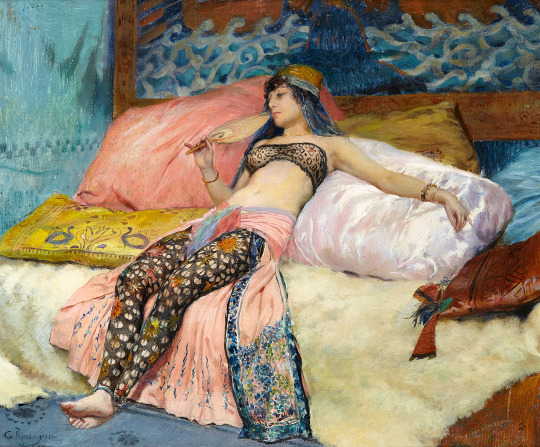
Portrait of Sarah Bernhardt (1844-1923) by Georges Antoine Rochegrosse (1859-1938)
#actress#sarah bernhardt#mdptheatre#stage costume#mdporient#20th c. orientalism#19th c. orientalism#orientalism
168 notes
·
View notes
Text
I was tagged by ཻུ۪۪♡.@sundered-souls ཻུ۪۪♡. in this fun little tag game! Thank you so much for thinking of me! ٩(ˊᗜˋ*)و ♡
I did something similar for Oli dear recently, so I thought I'd do this one for Ren c:
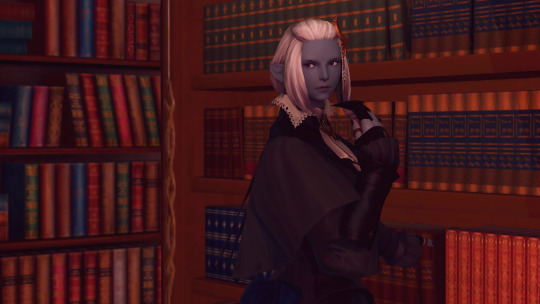
basics
Name: Cyfrenne Mirandis
(Phoentic: SIHF-ren MIH-ran-DIHS)
Nicknames: Ren, Frenne (used only by her uncle and occasionally Leontyne.) Cyf (used by Callineaux, to annoy her.)
Age: 34
Nameday: 19th Day of the Second Umbral moon
Race: Elezen
(Her model is Duskwight, but technically, Ren's family have been citizens of Sharlayan for like two centuries, so she doesn't really consider herself a Duskwight at all. She's got no knowledge of the clans experience in Gridania and The Shroud.)
Gender: Female
Orientation: This is hard for me to answer c': It never really comes up in my writing tbh, so I don't bother to think about it. I do ship her with my husband's characters for fun, but nothing we joke about in terms of ships are canon. Ren has no canon romantic relationships. She's married to her work and her research. I guess she's in a platonic life partnership with Oli? lol.
Profession: Archivist, Bibliomancer
physical aspects
Hair: White with hints of lilac, especially toward the tips
Eyes: Violet. One slightly darker than the other.
Skin: Slate blue
Tattoos/scars: None
family
Parents:
Father, Conarique Mirandis
Mother, Venesande Lorenaire
(unmarried)
Siblings: None she knows about, but neither of her parents were married so she could have half-siblings somewhere, potentially.
Grandparents:
Grandfather, Eyvanellain Mirandis
Grandmother, Milesevain Mirandis nee Urseult
Grandfather, Urmenost Lorenaire
Grandmother, Solette Lorenaire nee Haustefort
In-laws and Other:
Uncle, Zancefer Mirandis
Pets: None
skills
Abilities: Aetherolinguistics, Advanced Arcanima, Bibliomancy, Enchantment and binding cants, memory salads*
*I elaborated slightly on this previously here
Hobbies: Weaving, long walks at midnight, making jewellery (especially rings), gossiping and drinking coffee, reading, giving Leontyne social lessons, watching Callineaux lose at cards, eating Oliviede's baking.
traits
Most Positive Trait: She's fun!
Most Negative Trait: She's a liar :c
likes
Colors: Ren likes all colours, as long as they're combined tastefully with accompanying shades. Her favorite colour is gold. (I like to put her in purples and blues because I just like how she looks in those colours in game, but canonically, Ren wears a wide variety of colours and cuts of clothing. She' very vain, you know? c': )
Smells: Peppermint, frankincense, pepper, vellum, wax
Textures: Old parchment, soft chiffon, porcelain, lacquered wood, uncut gemstones
Drinks: Dirty Chai, hazlenut milk, something fruity with rum or gin (two shots!)
other details
Smokes: Not very often, but maybe something Oli offers her once in a while.
Drinks: Weekly, at least.
Drugs: See above comments regarding Oli.
Mount Issuance: Cyfrenne has a Chocobo whose name is Sorrel, he's very spoiled, he lives on Costa del Cobra with the rest of her uncle's Racing Chocbos.
Fun fact: Sorrel is the little brother of "Bonecrusher" a current, albeit rarely successful, racer at the Gold Saucer.
(Callineaux picked the name.)
Been Arrested: Not yet!
Tagging these beloved moots! As always, no pressure to do it/sorry if you've already been tagged! જ⁀➴♡⸝⸝ @angelinecarax, @dragons-ire, @archivumesoterica, @candycryptids, @improvised-finish, @the-unending-journey, @luck-and-larceny, and @dragonsongmakhali ʚɞ˚ ༘♡ ⋆。˚
#tysm for the tag! <33#tag games#ren#edited this to fix name pronunciation because I suck at phoentic spellings and it's not a real name so all the translators are like wonk c'
28 notes
·
View notes
Text
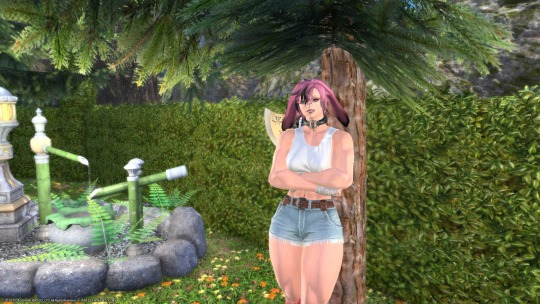
B A S I C S
Name: Flidais Oakclamber
Nicknames: 'Dais, Fli, Pinky
Age: 156, though she is
Nameday: 19th Sun of the 2nd Umbral Moon
Race: Veena Viera
Gender: Female
Orientation: Polyamorous Lesbian
Profession: Adventurer, Bodyguard, Blacksmith, Carpenter
P H Y S I C A L A S P E C T S
Hair: Pink Hair with dark tips
Eyes: Blue
Skin: Tanned
Tattoos/scars: Markings along either side of her nose (origin unknown) several scars from battle, deep scar encircling her throat that took her voice, which she covers with a choker
F A M I L Y
Parents: Unknown
Siblings: Tyjet, a twin 'sister', adopted as a sister by some of her Borlaqq friends
Grandparents: Uknown
In-laws and Other: Father-in-law on her wife's side
Pets: her trouble making Ruby Carbuncle "Ciabatta" he loves to steal clothing from Flidais and her visitors.
S K I L L S
Abilities: Formerly a powerful black mage, skilled Warrior, blacksmith, carpenter, bartending.
Hobbies: Reading, crafting, working out, flirting with women
T R A I T S
Most Positive Trait: Seeks joy in everything, the world is so full of joy and love and she wants to share it with all.
Most Negative Trait: too quick to jump to violence, even if it's friendly sparring.
L I K E S
Colors: purples, pinks, blacks. Colours that go well with her hair
Smells: Campfire smoke, books, fresh baked pretzels, coffee
Textures: the lips of a lover, the cover of a book, the grain of wood as you strip the bark, sheets tangled around legs as you sleep.
Drinks: coffee, fruity teas, cherry ale, the "punchcat" she serves at her girlfriends bar
O T H E R D E T A I L S
Smokes: Can't, it causes too many problems to her throat wounds
Drinks: Goes to bars to meet women, often
Drugs: Has never really tried any, just never came up. Strange with how much time she spent among the Pixies.
Mount Issuance: She has a Chocobo issued from the Twin Adders who followed her when she transferred to the Maelstrom. She named her Sapphobo and has been her stalwart companion.
Been Arrested: by the time she started to get into trouble, she was either such a powerful mage or so strong and buff that guards are intimidated to arrest her.
I was tagged by @hazelkjt !!! this was fun to do!
I'll tag @ariaofsasha and @isayoldbean and of course anyone else who wants to do it!
17 notes
·
View notes
Note
How do you find the time to read all your book recs?? Also would you mind talking about your process for researching specific topics :)
i generally only make rec lists for things i have enough familiarity with to navigate the literature so, you have to keep in mind those lists are sometimes literally a decade+ of cumulative reading on my end. i do also sometimes include texts i haven't read in their entirety, or occasionally even ones i've only come across in footnotes but still think are foundational or relevant enough to warrant a rec.
as to my research process: there's no single answer here because the sort of research i do will depend on what questions i'm trying to answer. usually if i'm starting to look at a topic completely from scratch, i'll ask someone who publishes in that area what the major recent works are, then scan a few of them. i might 'snowball' those texts (read the works they cite in their footnotes) but, that strategy has limited utility because it only goes backward in time and sometimes a recent or uncited text can be incredibly valuable. so there's a fair amount of bumbling around in the secondary literature at this point. some academic journals maintain bibliographies for their subfields, which are not comprehensive but can be useful; i usually also do a certain amount of keyword fuckery in my library's database. sometimes i waste a lot of time at this point chasing leads that turn out to be irrelevant, or i discover that a question i was chasing is really better tackled from an entirely different direction. shit happens.
at some point i usually reach a stage where i need to look at some primary sources, because i'm oriented enough in the major issues to identify spots where previous researchers haven't made full use of historical records, or may be interpreting them in a way i disagree with. so, what exactly i'm looking for now really varies. sometimes i just want to read the primary texts that another historian is commenting on: for example, the last few months i was trawling through the french national library's archives to see what people were saying in print about a specific historical figure between about 1778 and 1862. other times i might want population data or land records: births, deaths, cholera infections, records of church property sales, &c. depending on, again, what sorts of questions you're asking, anything might have useful information to you: postmortem personal auction catalogues have given me some mileage, along with wills and personal correspondance. i have a committee member who collects and analyses postcards often being sold for pennies at flea markets out of people's grandparents' attics, and another who has an ongoing project looking at a zillion editions of a specific children's book printed in the late 19th century. along the way, as i look at primary sources, i will typically go back and forth to more secondary literature, as i find new topics that might be relevant or help me contextualise what i'm looking at. i can't ever really plan these things out systematically; i just follow what looks promising and interesting and see where it leads me.
another thing to consider is that the primary sources sometimes tell me useful information directly in their capacity as material objects. what type of paper is used, what personal or library stamps appear on the cover, who's the publisher, how many editions did it go through, are the print and typeset jobs sloppy, where was this copy found or preserved? these sorts of details tell me about how people reacted to the text, its author, and the ideas within, which can be a valuable part of whatever investigation i'm trying to conduct. sometimes i end up chasing down information on a publisher or the owner whose personal library a book or piece of ephemera came out of; there are people who research processes of preservation, printing, &c in themselves, which has yielded some fascinating studies in recent decades.
at some point, if it's a research project i'm trying to communicate to other people, i will switch to writing mode, where i try to organise ^^ all of that in my head, and form a coherent narrative or argument that i think is worth making. this might be revisionist in nature ('people have argued before that such and such was x way or historical actors thought about it like y, but what i have here indicates we should actually understand it in the context of z') or it might be more like, "hey, i found this thing i don't think anyone knows about!" or anything else. again, the way you put together a research project will vary so widely depending on what you're researching, and why, and why you think it matters and to whom.
also, i should emphasise that what i've written here isn't necessarily something that happens on a strict or compressed timeline. i'm working on a dissertation, so for that topic, i do have reasons i want to complete parts at certain times, unfortunately. but i also have research projects that i just chip away at for fun, that i've had on various backburners for literally years, that i might sometimes write about (eg, on here) without necessarily ever planning to subject them to the hegemon of academic publishing. i think knowledge dissemination is great and to that end i love to talk to people about what i'm researching and hear about their stuff as well. but, i also think research projects can be fun / rewarding / &c when they're completely for your own purposes, untimed, unpublished, &c &c. i guess i'm just saying, publishing and research conventions and rules sometimes have purposes (like "make it possible to publish this as a book in the next 5 years") but don't get so hung up on those rules that they prevent you from just researching something for any number of other reasons. there are so many ways to skin a cat 📝
47 notes
·
View notes
Note
What's a ballet with real snazzy costume work, in your humble and/or professional opinion? c:
Oh, you’ve activated my trap card - asking about costume design and ballet and not expecting me to barf up the entirety of my PhD. I’ve also done work on the ballet blancs costumes (Giselle and La Sylphide specifically) but they are interesting on a theoretical level and not so much visually, so I’ll skip that.
So here are some personal favs of mine - the highlights, if you will. Caveat: long post, and mostly limited to the work of the Ballets Russes, because they are my longtime obsession and I think (and have argued) for their role in fundamentally changing stage and costume design (to say nothing of dance, and George Balanchine can sit the fuck down). I didn’t put that in my thesis but I wanted to.
Anyway tldr in the first decade of the 20th century a troupe of dancers from the Russian Imperial Ballet (later the Mariinsky) travelled through Europe under impresario Serge Diaghilev, for what became known as the Saisons Russes, or Russian Seasons. They performed both opera and ballet, and are probably best remembered today (if at all) as the troupe that danced the premier of Stravinsky’s Rite of Spring and caused a riot at the Theatre des Champs Elysées. The eminent artists that worked with them include Debussy, Cocteau, Picasso, Chanel - and these are only a few recognisable names. But my focus was primarily on the Russian roots of the ballet, in their visual language and presentation of gender and nationality, more precisely around the work of artist Leon Bakst and dancer Vaslav Nijinsky.
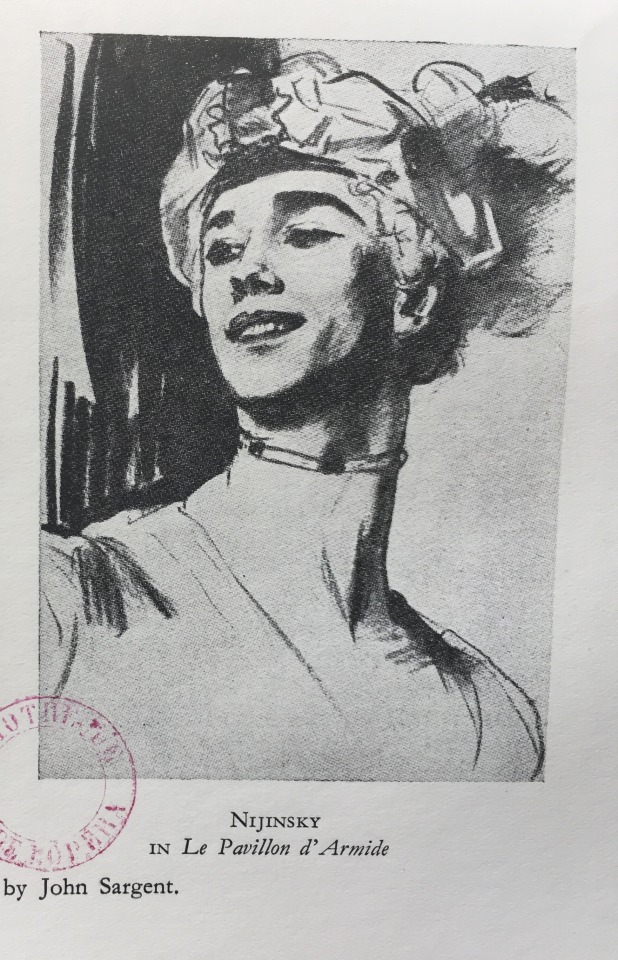
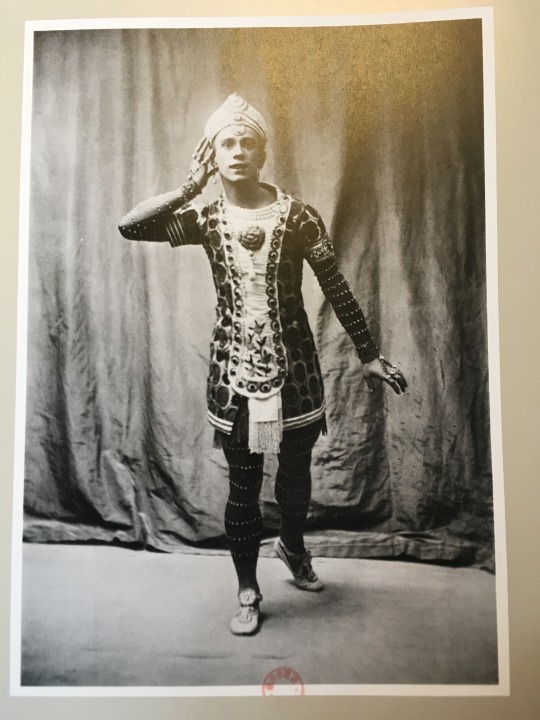
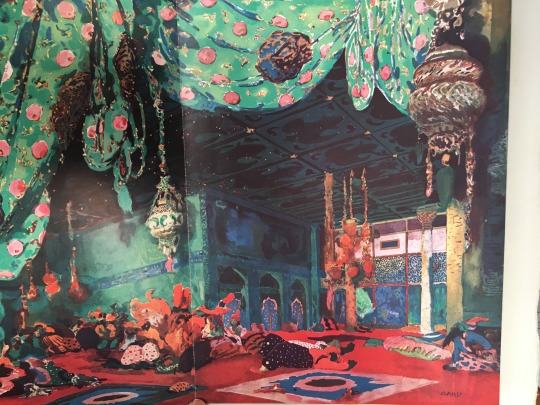
Second image of Nijinsky from Le Dieu Bleu, and Bakst’s set design from Scheherazade (1911). These are mainly photos and scans I have from the year I spent in the archives of the Palais Garnier (the Paris Opera) where all the good stuff is.
The crux of why these costumes are insanely interesting to me is because they are very specific to their time - they are a product of a resurgence in nationalist interests in Russian art (Diaghilev ran Mir Isskustva and worked with Savva Mamontov before he organised the BR) as well as a carefully crafted, highly artificial presentation of Otherness, expressly destined for export to the west. French audiences in the first decade of the 20th century (because there is a stark cut-off at the beginning of WW1) still had an appetite for Orientalism, despite their flagging colonial power. What the Russians brought them was compelling mix of performative Orientalism just vague enough to be appealing and fantastical, visually intriguing, and refreshing to a society that had otherwise come to recognise itself as decadent, fallen “victim” to modernity. In the athletic virtuosity of Russian bodies, Bakst’s exotic visual language and the soaring music of Rimsky-Korsakov and Stravinsky, the French devoured what they deemed a sort of noble savagery (yes, that kind). Despite the oversaturation of Orientalism in painting throughout the 19th century, the French identified a kind of masculine vigour and freedom in these live performances they found they themselves lacked, and longed for. Primitivism, as demonstrated in myriad ways by the BR, was for them a way to reconnect with a virility that they felt modernity had stolen, or at the very least, weakened. If you think this sounds eerily akin to the discourse around mounting desire for war to “cleanse” or “reset” Europe during that same period, you are right.
A few of Bakst’s lesser known designs from the archive, for context (including a reprod by Barbier which I don’t have the OG of but is saved in my Bakst folder so please take my word for it). I have a thousand more of these but tumblr has an image limit per post 😤

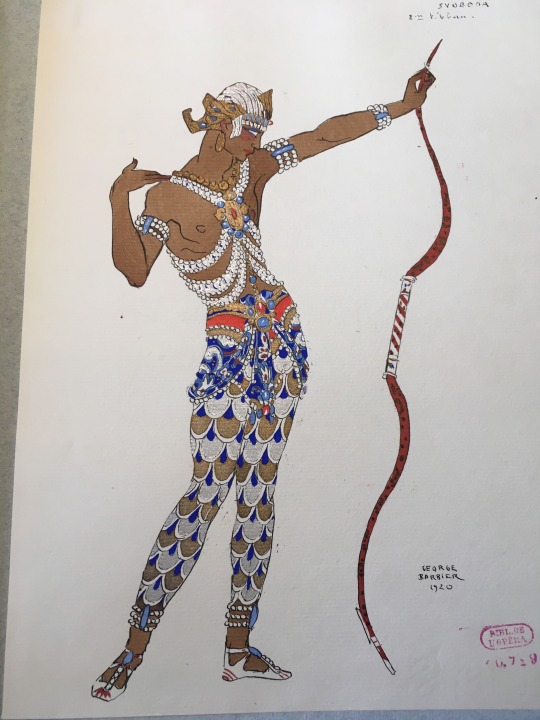

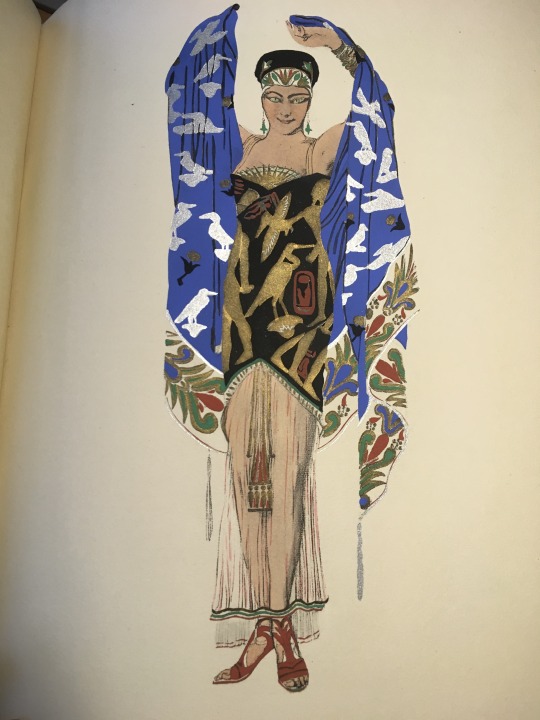

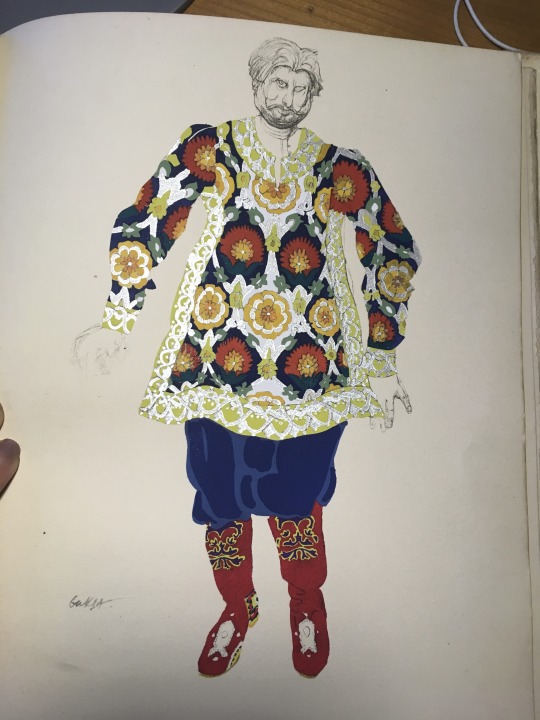
Tamara Karsavina, who often performed with Nijinsky, and one of my most beloved historical figures. The existence of a strong classical ballet cirruculumin the UK today is in part thanks to her.

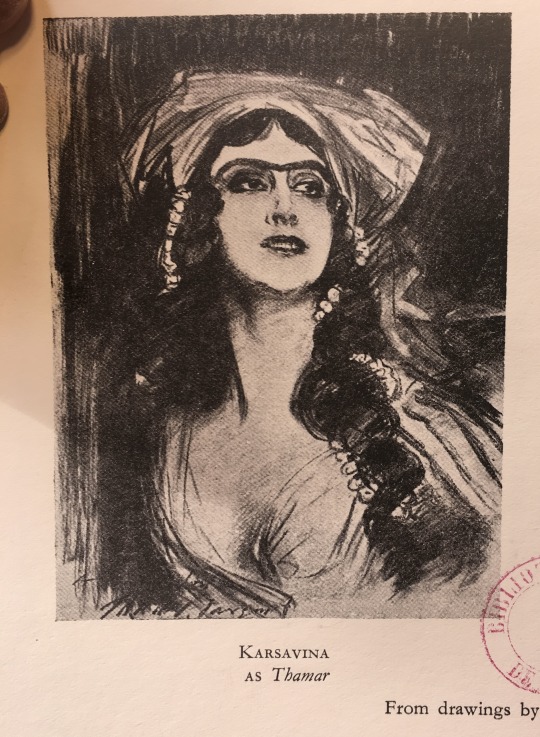
One of her most famous roles, as the Firebird:
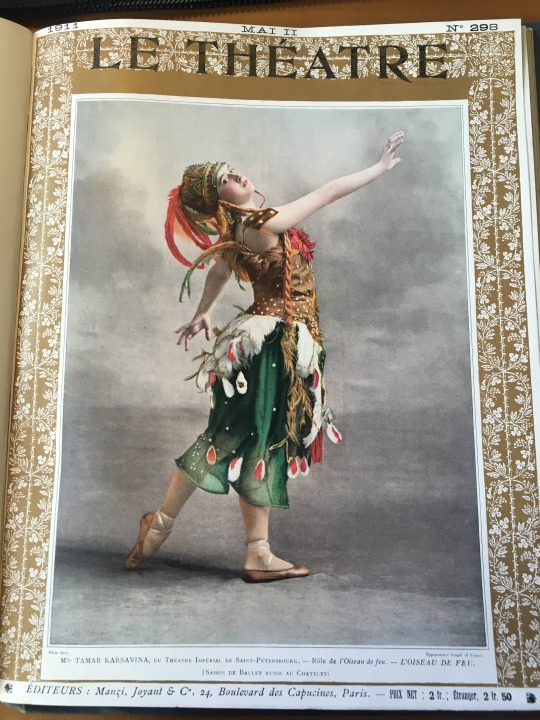
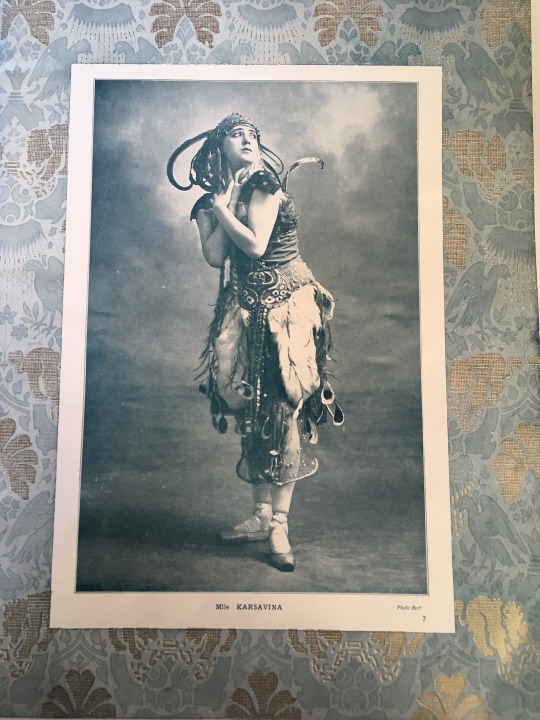
Nijinsky is by far the most interesting figure to come out of the BR. He combined virtuosity and strength (that most audiences identified as masculine) with a glittering, joyful, and expressive queerness on stage (and off). Some of his greatest roles are expressly feminine in their costume design: Le Spectre de La Rose, for example.
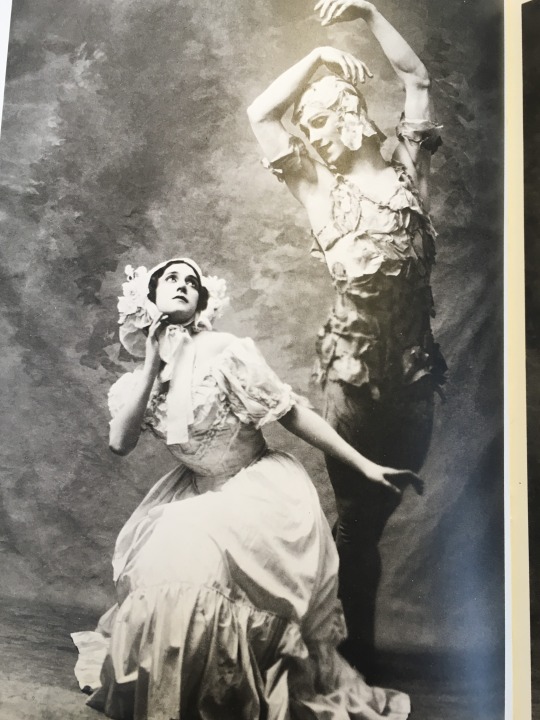
There’s a colorised version of this out there where you can see every pink rose petal on him.
While others are much more decorative but still markedly Orientalist (or Russian-Orientalist): Le Dieu Bleu, La Peri, Les Orientales, L’Oiseaux de Feu.

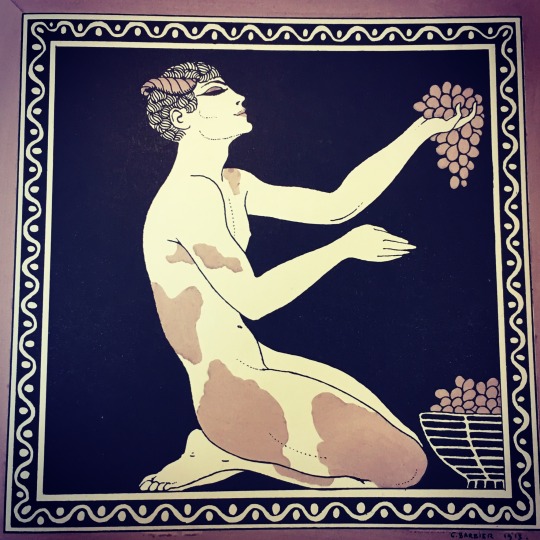
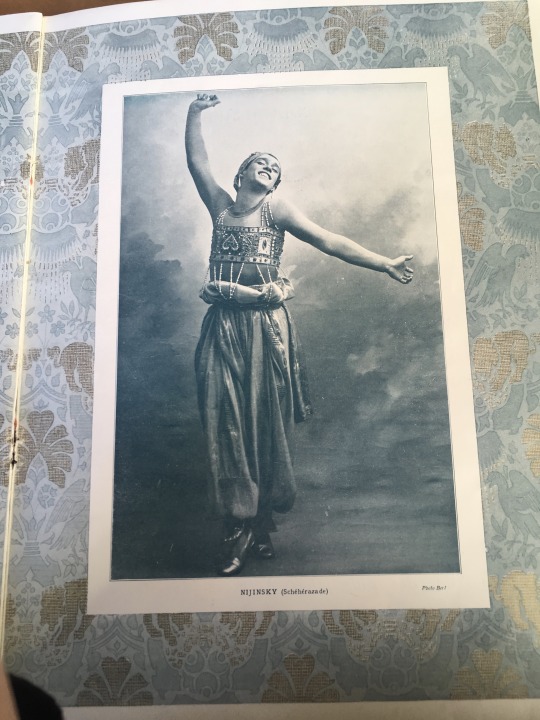

This last image above is not, the last I saw it, in a private collection. It hangs above the vestibule of the Palais Garnier archives (also Napoleon’s private hangout room) where it faces the sort of “diptych” version that features Karsavina, and on occasion I would stand below them and weep quietly).
Either way, there is an argument to be made about Nijinsky’s physicality and, more importantly nationality as a kind of avenue of permission through which the French could admire both his beauty and athleticism and even, to a degree, imagine themselves in his place while still maintaining that safe distance of Otherness.
But I would argue that his greatest role was the Golden Slave in Scheherazade, a wild, erotic orientalist fantasy that has little to nothing to do with the actual tale of Scheherazade. In it, Nijinsky - bejewelled, wild, ecstatic, (and yeah often in blackface) - cavorts with Zobeide, the Sultan’s favourite, in a very sexually explicit storyline. Both characters are equally decorative in their costumes, and both, in real life, were recognisably queer(ed) figures. It’s Scheherazade in particular that helped accelerate an obsessive trend in fashion (Paul Poiret was at the centre) for Orientalist design. Bakst himself did some silhouettes that are hard to distinguish from his costume design, and through the remarkable illustrations by Paul Iribe, Georges Lepape and Georges Barbier, we can see some of the blatant repetition of motif and silhouette in these ensembles that are designed, among other things, to be worn to the theatre.
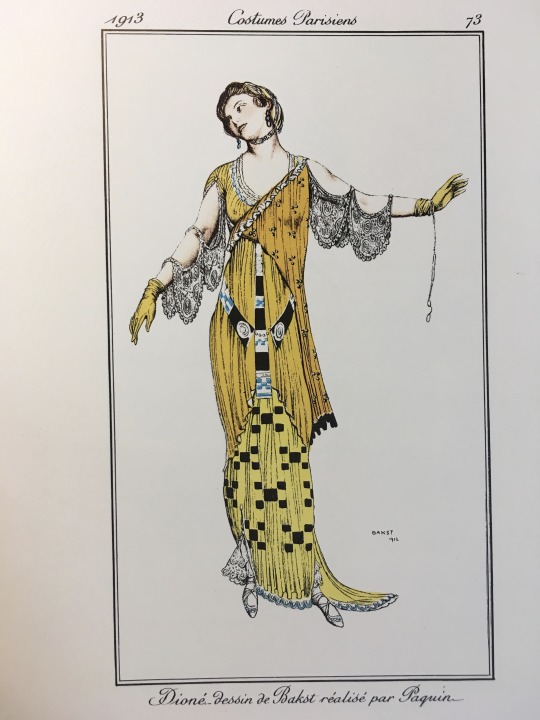
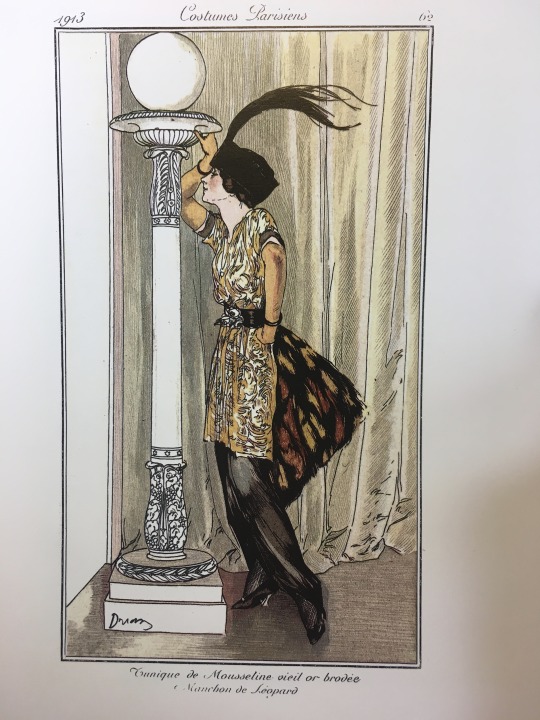
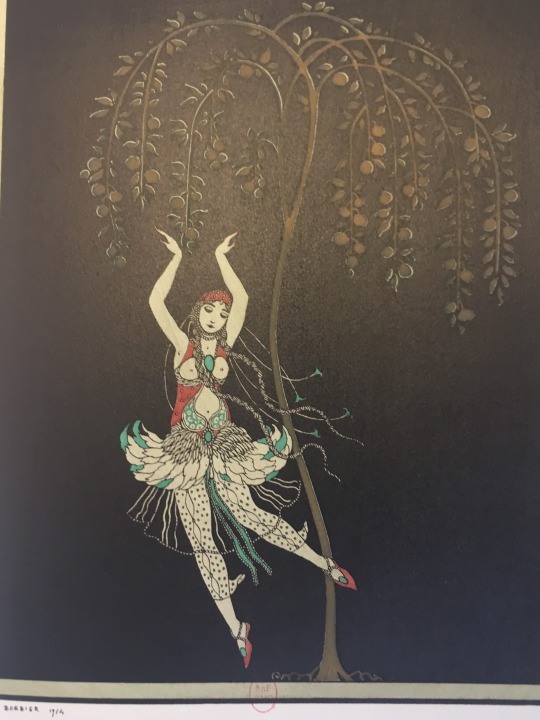
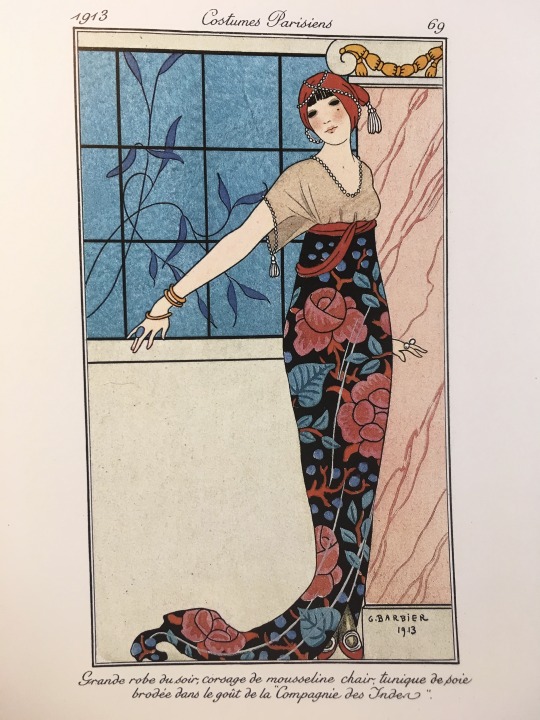
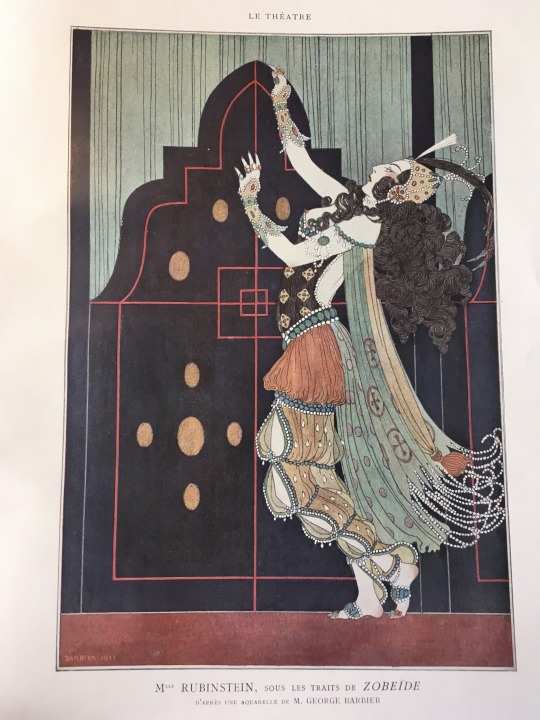
3rd and 5th are depictions of costumes of the Firebird and Zobeide respectively; the rest are fashion plates. This doesn’t even include the lampshade dress - which I don’t have a handy picture of, but have seen in real life - that is a pretty blatant melange of the Firebird and Zobeide, as designed by Poiret. Below is one of my favourite examples: A woman in a lampshade-style dress, standing against a backdrop not unlike Bakst’s set design above, attended by a archetypal oriental servant wearing Nijinsky’s Golden Slave costume.
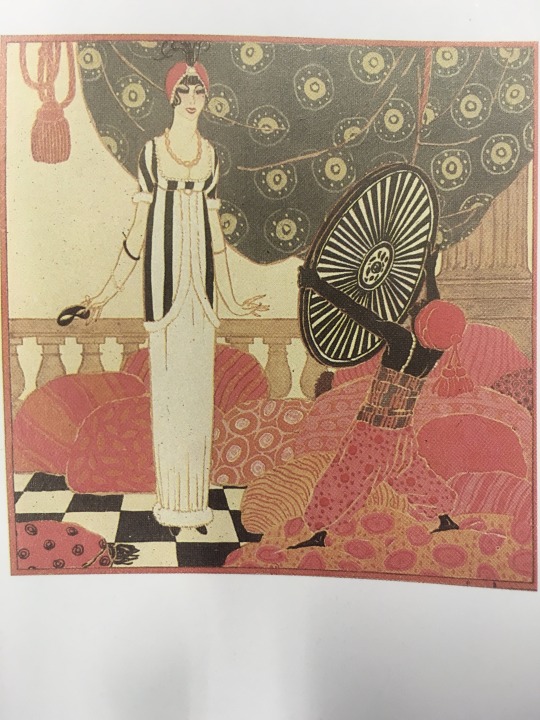
These motifs also proliferated in advertisements and in all kinds of other consumer products (perfumes, for example, and decorative objects). Thus, there’s a performative aim in wearing these designs that I read as a sort of pseudo-kinetic empathy (and can funnnily enough probably be compared to cosplay). There is an attempt here to channel what is being presented onstage, to reenact it, to physically embody it, in the way that fashion is, at its core, a tool through which to construct identity. That the French pulled inspiration from an openly queer man leaping across the stage dripping in jewels, and from femme fatal-style odalisques, says a lot about the visual and cultural impact the BR had on the theatre-going public at the time.
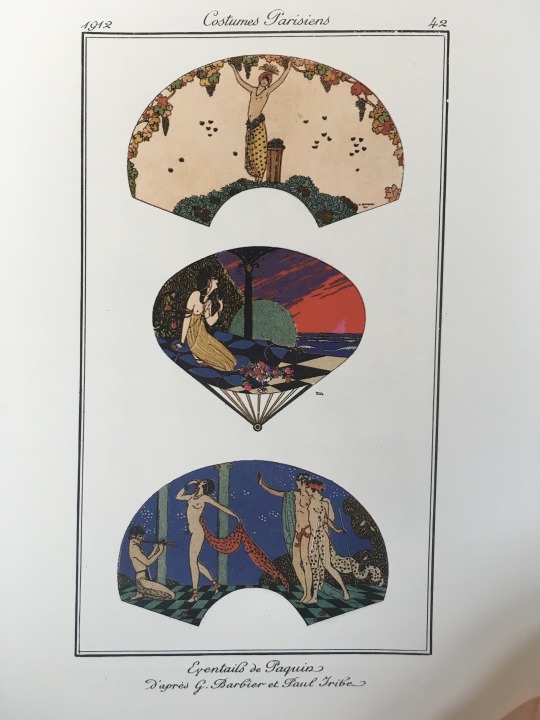
You can see in these fan designs by Paquin some pretty obvious references to the BR aesthetic: L’apres-midi d’un faune, Daphnis et Chloe, Scheherazade, even a little Le Pavillon d’Armide in that first one.
Nijinsky was not the only one to queer the stage: despite not being a dancer trained to the level of the BR troupe, Ida Rubinstein, no doubt purposefully channelling Sarah Bernhardt, was also a beloved stage presence, whether as the sly harem favourite Zobeide or as the strikingly androgynous St Sebastian, gayest of saints.

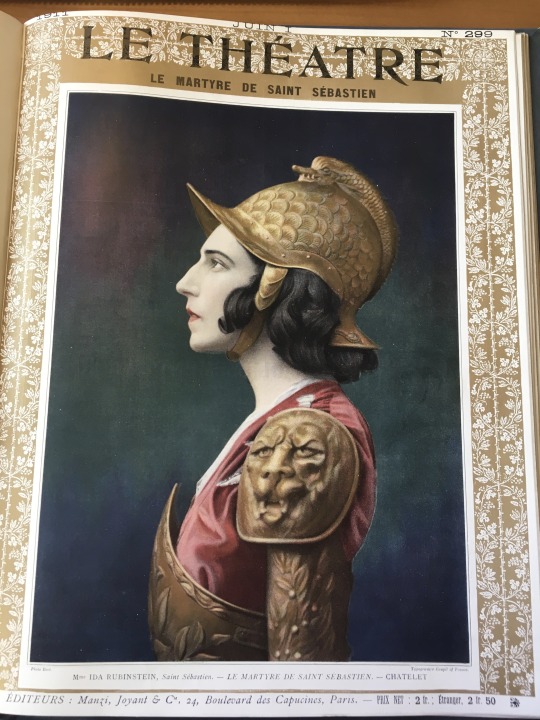
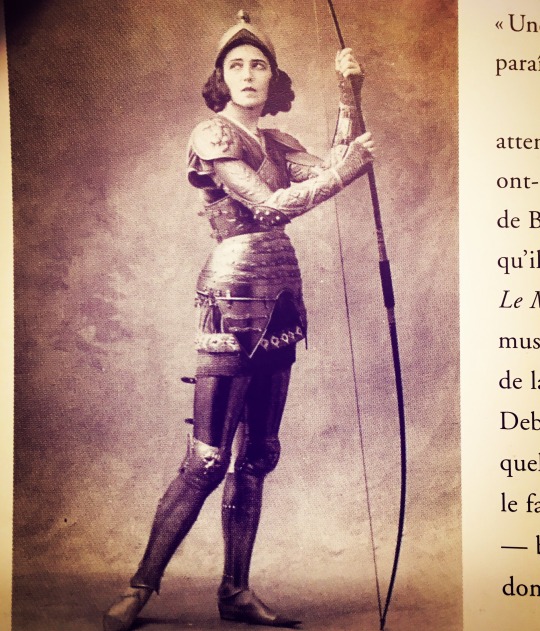
This is not to say there haven’t been wonderful and brilliant costume designs since - and quite a few known fashion designers working alongside dance companies, to great success or otherwise. I will, however, shoutout my favourite contemporary work: Akram Khan’s Giselle, which has everything and yet nothing to do with Adolph Adam’s 1842 piece. I don’t even want to post pictures because the costumes of the nobles (the landowners, in this very apocalyptically late-stage capitalist version) are so fucking breathtaking in relation to the overall design, and their entrance itself is probably one of the most spectacular parts of the ballet, that all I can say is just see it. Or buy the dvd. What Khan does gesturally is beyond words, what Vincenzo Lamagna does with Adam’s original score is visceral and haunting and churns my insides. I make a point to see it live at least once a season when it’s touring with the ENB, and I will do so until it leaves the repertory or until I die. It’s my contemporary Scheherazade. It’s a gesamtkunstwerk.
Tldr Leon Bakst is one of the greatest costume designers of the 19th and 20th century and criminally underrated.
It’s not ballet, and it’s not the sumptuous costumes from Boris Godunov, but as a bonus here’s my favourite image of opera star Fedor Chaliapine as Ivan the Terrible.
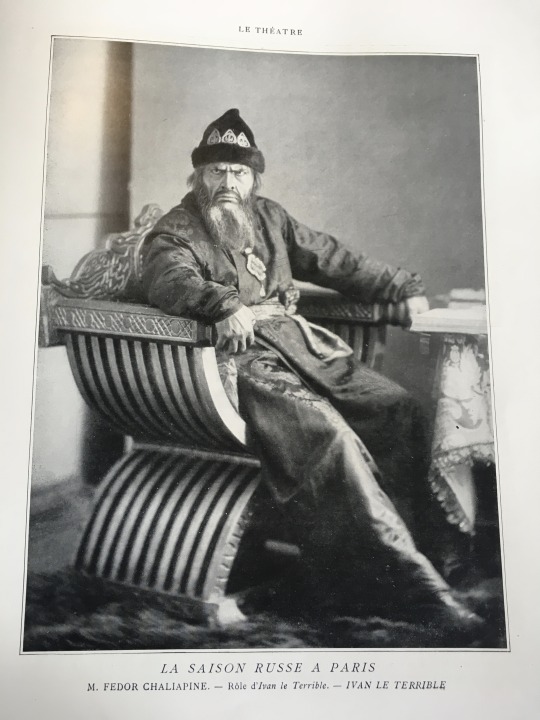
#Thank you for the enclosure enrichment#And for coming to the tldr of my thesis#ballets russes#vaslav nijinsky#Leon bakst#fashion design#academic indulgence hour#Art history
49 notes
·
View notes
Text
Bem Dei-ijla B A S I C S

Name: Bem Dei-ijla
Nicknames: N/A
Age: Early Fifties
Nameday: 19th Sun of the 3rd Umbral Moon
Race: Rava Viera
Gender: CIS Male
Orientation: Pansexual
Profession: Handyman.. Cat (Bun?) burglar
P H Y S I C A L A S P E C T S
Hair: Messy. Just above the shoulders. It always seems like he just got out of bed. The hair is black with a very light brown highlights.
Eyes: Right eye is a lemon yellow and his left eye is scarlet red. Both eyes glow constantly, having a vibrant life behind them.
Skin: Tanish, hazel skin. Freckles throughout his body.
Tattoos/scars: Tattoos on both side of his right forearms, his back and his left shoulder. An incision scar over his right eye. A few burn scars, most notably on his left shoulder above his tattoo and his hands.
F A M I L Y
Parents: Unknown to him but he knows that they are deceased. Ceres Dei-ijla (Adoptive Mother)
Siblings: Ris Dei-ijla (Adoptive Sister)
Grandparents: N/A
In-laws and Other: N/A
Pets: Rainforest frog, Hopper.
S K I L L S
Abilities: - Quite skilled with daggers in both hands. Some practice with a bow and longsword. Though it's not his first choice.
- As a wood-warder, he was taught in stealth, tracking and hunting.
- Basic fire magic. Has the capabilities to enhance them but chooses not to.
Hobbies: Camping, gambling, stargazing, knife tricks, fishing, eating (like a foodie), pottery (badly)
T R A I T S
Most Positive Trait: Self- confidence. He's able to do challenges head-on, laugh at himself all to a fault.
Most Negative Trait: Self- destruction. Sometime his confidence overcomes his own logic. He has been known to push himself to the point of accidently hurting himself. Though he is careful not to hurt others, it can happen.
L I K E S
Colors: Brown, white, red, yellow.
Smells: Campfire smoke, woods, fresh cut grass, roasted vegetables, smoked fish.
Textures: The small bumps of a toad/frogs skin, feathers from a bird that flew by, the dry paints of a painting.
Drinks: Teas, coffees, ciders, cocktails.
O T H E R D E T A I L S
Smokes: Occasionally, usually at parties.
Drinks: Occasionally.
Drugs: Yes, but he doesn't go out of his way to take/get them. If it's offered the answer would be yes.
Mount Issuance: N/A
Been Arrested: Yes, more than once. More so in his youth than now. He's more careful. :3c
This has been such a huge help to actually sit down and write about Bem. Now to actually finish my carrd. Thanks for tagging me! @this-is-ris
18 notes
·
View notes
Text
Orion D'Oschon

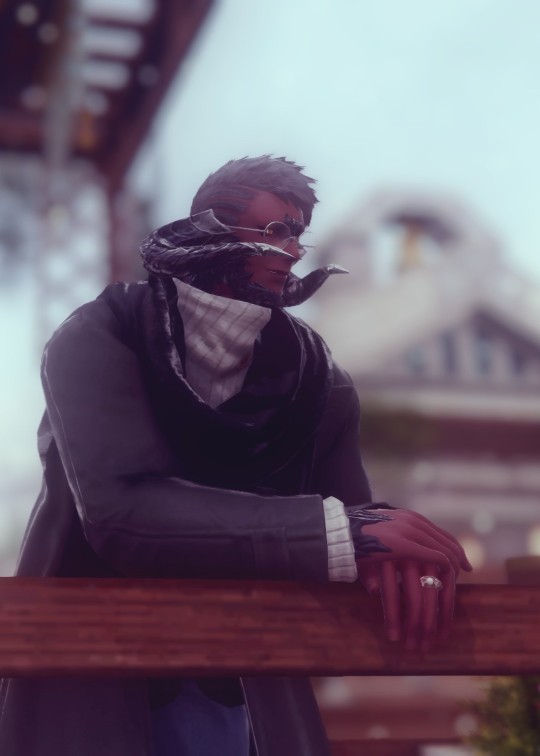
— B A S I C S
Name: Orion D'Oschon
Nicknames: Rion (mostly G'raha), Legs or Specs (mostly Kendra)
Age: 30ish
Nameday: 19th Sun of the 5th Astral Moon
Race: Xaela
Gender: Cis Male
Orientation: Bisexual
Profession: Warrior of Light, Aetherologist, part-time Historian, Botanist
— P H Y S I C A L A S P E C T S
Hair: Burnt Umber (Very dark reddish brown), kept short except for a section of braids along his right temple. Orion's hair is very thick and dense, giving a matte or velvet effect in the light.
Eyes: Amber with golden limbal rings
Skin: Umber (a bit lighter than his hair but in the same color family)
Tattoos/scars: He's got a pretty big scar running down his left leg from the fight with Zenos in Rhalger's Reach, small surgical scars around his knees from where he had to have reconstructive work done after Endwalker, and a small Mol clan tattoo on his inner wrist.
— F A M I L Y
Parents: Dolgoon Qestir (father) and Odsetseg Mol (mother). Both are alive and well and living in Ul'Dah. They also use the D'OSchon surname in Eorzea.
Siblings: None.
Grandparents: Temulun Mol
In-laws and Other: Cousin - Cirina Mol. Various other cousins, aunts, and uncles within the Mol tribe. No In-laws, Kendra doesn't have any living family.
Pets: Birdlegs (chocobo), Lily (Eos, she's not a pet, but she's important and I wanted to list her), Walpole (a very bitchy Carbuncle).
— S K I L L S
Abilities: SCH main (Scholar questline is canon for him), aetherology (he started his work with the Scions as Y'shtola's personal assistant), experienced and competent field medic, unique echo manifestation gives him the ability to see the flow of aether around him in a synesthesia-like effect.
Hobbies: Reading, astrology (learned from his mom), botany and gardening, botanical drawing, alchemy, helping Kendra in the kitchen, knitting, letter writing.
— T R A I T S
Most Positive Trait: Orion has an inquisitive mind. His desire, not only to know but to fully understand phenomena has led him to several ground-breaking discoveries. And he does not hoard knowledge. He'll enthusiastically share his findings with anyone who cares to listen. He is also just as inquisitive and keen to understand in social situations, making him an empathetic and open-minded person in general.
Most Negative Trait: Orion has a deep-seated distrust of governments and other institutions of traditional authority. This is not without reason, or even some merit, but it can make him difficult to work with when it comes to large-scale endeavors. His words or actions have nearly cost the Scions a deal more than once.
— L I K E S
Colors: Blue, especially woad, ink, and rhotano blue / Green / White / Warm browns / Metalics, especially gold.
Smells: Sandalwood, cedar, oolong tea, jasmine (reminds him of Kendra's perfume), libraries and well-preserved old paper, and morning fog in the Dravanian highlands.
Textures: The downy fur of Kendra's ears / yarn spun from the karakul of the Azim Steppe / well-loved leather-bound books / smooth, expertly-blown alchemical glassware.
Drinks: Tea, especially oolong or pu-erh. If Orion does not have access to actual pu-erh, he will make an equivalent with the darkest Sharlayan-style tea blend he can find, a custom blend of additives he will not divulge, and karakul milk. Just tasting it once put Urianger in a sickbed for two days. / Botanical spirits such as gin and aperitifs. He's even made a few himself.
— O T H E R D E T A I L S
Smokes: Medicinally smokes whatever variety of moko grass gets you stoned. He will also occasionally smoke tobacco socially, especially cigars.
Drinks: An adventurous but moderate drinker. He'll try anything at least once. He can occasionally be cajoled into heavier indulgence but that's abated as he's gotten older.
Drugs: There have been a few controlled "experiments" over the years.
Mount Issuance: Birdlegs is his primary mount that travels with him almost everywhere. The dusky, gigantic chocobo has become a bit of a legend in her own right. However, he does also technically have a yol as well, but has entrusted Cirina with his care because there's just not enough room on any of his properties for a bird of that size.
Been Arrested: For a mild-mannered professor type, Orion has been arrested so many times.
Tagged by:@ardberts🤍 tyyyy! Tagging: @physicalvocalist@sarenraegalpaladin@janzoo@airis-ray@ae-fond-seeker@captainqster@koijikido@adina--astra@iron-sparrow Sorry if you've already done this or been tagged before! I tried to pick mutuals I hadn't seen this from yet.
7 notes
·
View notes
Text
Kitali Moonblade

B A S I C S
Name: Kitali Moonblade
Nicknames: Kit for a select few
Age: 30s? probably? She doesn't know exactly anymore
Nameday: 19th Sun of the Fifth Astral Moon
Race: Xaela
Gender: Tomboy
Orientation: Bisexual
Profession: Mercenary, artisan
P H Y S I C A L A S P E C T S
Hair: Pale pink, thick and slightly wavy, down to the small of her back
Eyes: Black sclera, deep purple iris, gold rings from Hraesvelgr
Skin: Cool blue-purple.
Tattoos/scars: No tattoos, several scars. Most notable is the large scar running along the top of her left arm near the elbow from the fight with Estinien.
F A M I L Y
Parents: Baidur Gesi (deceased) and Tsenxer Dazkar (unknown)
Siblings: only child, later adopts the Leveilleur twins as her siblings
Grandparents: They exist, most definitely, I just haven't gotten around to fleshing out her family trees.
In-laws and Other: None, both of her partners' parents and families are dead.
Pets: Arienne, Aymeric's cat, and her black chocobo Belle
S K I L L S
Abilities: DRG/NIN hybrid, omnicrafter
Hobbies: Reading, ruin exploration, embroidery, gardening
T R A I T S
Most Positive Trait: Deeply loyal and protective to the people she holds dear
Most Negative Trait: Hypocrisy to the tune of "this isn't about me right now"
L I K E S
Colors: Purple, blues, black, silver
Smells: Fresh plants, petrichor, warm stone, woodsmoke, damp earth, lavender, roasting meat
Textures: Smooth linens and cottons, leather (not suede), anything quilted or embroidered
Drinks: Tea, ale, whiskey
O T H E R D E T A I L S
Smokes: She used to, on and off, but more of a social thing than a need
Drinks: Only when she is absolutely safe will she let her guard down enough to get drunk. When at large social events she will only drink from her hipflask.
Drugs: Again, only when she is safe enough. She needs to take the edge off things a lot when she gets too restless.
Mount Issuance: Her black chocobo lives in Ishgard. I'm still waffling on how canon I want to make her GC mount since she really doesn't use him to get around much. Midgardsormr and later Fylgja are her go to mounts everywhere but the First. Her yol is still out on the Steppe but has likely gone feral by now.
Been Arrested: oh my god so many times. The Scions really should do better background checks on their new recruits.
Tagged by: @eriyu tysm 💜
Tagging: @maeljade @gatheredfates @iron-sparrow @hazelkjt @dragons-ire @emahriel @uldahstreetrat @anneapocalypse @whatsthisascianbullshit @tallbluelady @tripl3cast @sundered-souls @ardberts @alannah-corvaine @drowxiv @mrlarkstin (zero pressure)
18 notes
·
View notes
Text

character profile
► basics:
Full name: Brooke Riley Killingbeck
Meaning of name:
Brooke is a gender-neutral name of English and German origin meaning water or small stream. It is said to be derived from the Old English word bróc, which translates to brook or stream.
Riley is a gender-neutral name of British origin meaning rye clearing, courageous and valiant.
Nickname: B by The Five Club, Brookie by his brother but he dislikes this, Killingbeck by Vanya
Pronouns: He/them
Sexual Orientation: Bi
Nationality: British
Birth date: November 19th, 1988
Zodiac sign: Scorpio
Scorpios born on November 19 are likely to keep their own counsel. These self-controlled, taciturn individuals make good leaders yet do not mix well with others. One of their greatest talents is to make others feel good about themselves. Although seemingly aloof, they possess much charm.
Age: 16 during the start of his story
► Physical appearance:
Faceclaim: Mark Eydelstein

Older Faceclaim: Adam driver

Height: 182cm
Eye colour: gray
Hair colour: dark brown/black
Tattoos or Scars: has a big scar on his left cheek after a duel with Vanya Kavinsky at the end of his seventh year in school.
► Personality:
Positive traits: intelligent, fair, independent, creative, reserved
Negative traits: moody, private, anxious, gloomy, uncooperative
Personality type: INTJ
Character’s greatest joy in life: his friends
Fears: spirits that haunt him and his family history, The Other World, losing his friends
Why?
Brooke's family line has a connection to death and he can see spirits who wander in the world and can’t pass to the other side but who are not ghosts either. Sometimes they can hurt him and he can't control this ability.
Brooke has hard time showing that he cares but he loves his friends very much and he doesn’t want to be lonely.
Priorities: his friends, finding a way to get rid of his connection to death and darkness
Character’s soft spot: Darby, Judy
Is this soft spot obvious to others? His friends know that Darby is his favourite out of them all, Judy becomes important to him later on and then it’s obvious to everyone.
Greatest vulnerability or weakness: his family line
Biggest regret: Losing his brother in the dark realm, trusting Vanya Kavinsky
Secrets of the character: His family secret and his love for Vanya
Does anyone else know?
Eventually people find out about both.
Drives and motivations: Getting rid of his powers and finding out more about the other world
► Past
Hometown: Wiltshire
Type of childhood: Brooke lost his parents during the second wizarding war and was raised by his grandparents. He doesn’t get along with his older brother Hale.
Religion: Brooke's grandparents are Christian but he doesn't identify with their religion that much.
Dream job: Historian
► Present
Currently living with: During his teenage years he lives with his grandparents in Wilthshire. In his adulthood he moves in with Judy and they live in Oxford.
Pets: A crow who's part of The Entity follows him from The Other World sensing his energy and connection to death. The crow becomes his companion but bears no name as Brooke mostly fears the being.
► Magical info
Blood Status: Half blood
Education: Hogwarts
Hogwarts house: Ravenclaw
Wand: Holly wood with a phoenix feather core, 14 1/2 and reasonably supple flexibility
Holly is one of the rarer kinds of wand woods; traditionally considered protective, it works most happily for those who may need help overcoming a tendency to anger and impetuosity. At the same time, holly wands often choose owners who are engaged in some dangerous and often spiritual quest. Holly is one of those woods that varies most dramatically in performance depending on the wand core
Patronus: Russian blue cat (it was his mother’s patronous as well as his)
The Russian Blue is known as a royal cat. Regal in form and frame, they love attention and actively seek it out. They love their humans, often doing small acts of kindness to cheer you up such as patting your face or clowning about to entice a laugh. If any Patronus will chase away a Dementor by staring disdainfully at it, this is the Patronus!
*authors note: the patronous is the opposite of him in so many ways that perhaps it will protect him well from evil*
Patronus Memory: Spending time with The Five Club, Judy laughing, sometimes moments with Vanya but he hates when that happens.
Boggart: When he's younger it’s the first spirit he ever saw but after witnessing the horrors of the dark world he sees the entity of it killing his brother, sometimes he sees Vanya cursing him.
Specialized/Favourite Spells: Expelliarmus
Favourite subject in school: History of Magic, Latin, Defense Against The Dark Arts, Alchemy, Arithmancy, Study of Ancient Runes
Special abilities: seeing spirits, has a connection to darkness that can't properly control
► Family
Father: Aeneas Killingbeck
Relationship to them:
Brooke's father had the family lines connection to death but he wasn't sensitive for the abilities that came with it. He has a brother who he was not close with. Aeneas died during The Second Wizarding War.
*authors note: i used yardley's middle name for him to honour of him*
Mother: Amie Orrell
Relationship to them:
Brooke's mother was a muggleborn witch. Death Eaters killed her and her husband over her blood status. He has fond memories of the times with his parents though he doesn’t remember them as well as his brother.
Grandparents: Riley & Piper Orrell
Relationship to them:
Brooke was raised by his muggle grandparents who lived on a small farm in plaah. Brooke was always close to both of them and could count on them for advice on many things. Neither of them understood his abilities and thought he was making them up and for the longest time Brooke thought he just had a big imagination. His grandfather died when he was 13 and the rest of The Five Club attended his funeral to support Brooke. Brooke wears Riley's old coat.


Brother: Hale Demetrius Killingbeck (b. 1984)
Faceclaim: Manu Rios

Relationship with him:
Hale is Brooke’s older brother. The two have a troubled relationship. While they attended Hogwarts Hale was very popular and the captain of the Slytherin quidditch team.
After their grandfather passed Hale felt responsible to take care of his little brother and grandmother and he took a more fatherly role which annoyed Brooke. Hale always had strong opinions on how Brooke should behave and who he should spend time with disapproving his relationship to Vanya Kavinsky and thinking that he's troubled.
Brooke was more sensitive to the Killingbeck abilities while Hale tried to ignore his own connection to the dark. He lied to Brooke about his own experiences making Brooke think he was the only one who had them. Eventually the two came by Demetrius Killingbeck's old writings and found out the truth of their abilities.
During Brooke’s sixth year at Hogwarts Hale got a job as the assistant of Sasha Kavinsky to Brooke’s great displeasure.
He eventually became involved in the five clubs adventures to the other world.
During Brooke’s seventh year he saved The Five Club by staying behind in The Dark Realm. Brooke believed him to be dead for a long time and felt guilty over his fate.
When Brooke was 28, The Five Club returned to The Other World and Hale was found not having aged a day while being stuck in there. He returned back home with Brooke struggling to cope with his new life.
Ancestors: Demetrius and Yardley Killingbeck @cursebreakerfarrier
Faceclaims: Noah Saavedra & Barton Cowperthwaite

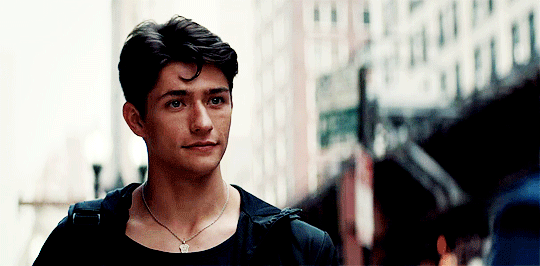
The Killingbeck brothers were the sons of Julian and Danica Killingbeck. They experimented with alchemy as young men and caused the death of their sister in the process. Demetrius got connected to the darkness and death while Yardley was connected to the light. Demetrius later sacrificed his own life to save his brother but accidentally offended death enough to cause a sort of curse on his family line. His family members always had at least two sons and the other son was destined to die, may it be as a baby or later in life. Many of his family members were also haunted by death and had special abilities.
► Love interests
Vanya Kavinsky @gaygryffindorgal
Face claim: Felix Sandman

Relationship with him:
Brooke and Vanya were both sorted into Ravenclaw and there was a great chance on them becoming friends during the first months. However when Brooke started getting close to the other Five Club members Vanya grew jealous and the two became rivals. Later on, when Brooke was having trouble with his friends the two grew closer again and started to hook up occasionally. Brooke didn’t want to admit to his feelings and Vanya was always unpredictable.
Later on Vanya betrayed him because of his fathers plots and schemes and hurt Brooke in the process causing him the scar on his right cheek.
Judy Bones @gaygryffindorgal
Face claim: Violet Brinson

Relationship with her:
Brooke got to know Judy as Jesper’s girlfriend. During the sixth year the two became friends on their own which led the other members of The Five Club to think that the two were involved with each other in secret. This caused a rift between the friends. Later on during their seventh year after Judy and Jesper had broken up the two started to grow closer again and developed feelings for each other. 5 years from graduation (and Vanya’s betrayal) the two started to officially date.
► Enemies
Sasha Kavinsky, The Dark Entity, later Vanya Kavinsky
► Favourites
Colour: black and blue
Food: his grandmothers dishes
Literature: likes reading and is a fan of horror stories
Most loved possession: his grandfathers old coat
► Habits
Spending habits: is thoughtful with using money
Smokes: Yes
Drinks: Yes
Other drugs: Sometimes
What does he do too much of? Sulking, spending time with Vanya when he really should not, being obsessed over The Dark Realm, swearing
What does he do too little of? telling people about his issues and talking about his feelings
Extremely skilled at: school, Latin, learning new things, chess
Extremely unskilled at: talking about his feelings, sleeping
Hobbies: playing violin, painting, reading
►Traits
How he feels about himself: He loathes himself and often wants to distance himself from others in fear of getting them in danger
How do other people perceive him:
Private and mysterious but interesting, people often think of him as Hale Killingbeck's younger brother (which he hates)
Style:

► Relationships with others
Does the character hide his true opinions and emotions from others? He hides his abilities from other people for a long time, though he doesn’t speak that much about his own feelings he is loud about his opinions and plans.
Person character most hates: eventually Vanya but he also loves him.
Best friend(s): The Five Club
The boys of the Five Club met on the first day of school and became inseparable as time went on. They’re called the Five Club because everyone at Hogwarts knows how close-knit their friend group is.
Darby Rosen @gaygryffindorgal
Faceclaim: Kelvin Harrison Jr.

Relationship with him:
Out of his friends, Brooke is the closest to Darby. Brooke always felt the most comfortable around him and he's the one who Brooke speaks most out of everyone in his life. Darby is also the first one to learn about his secret. When Darby gets affected by The Entity during their seventh year, Brooke feels strongly about finding the fix for it and saving him.
Harker Hartford
Faceclaim: William Franklyn Miller
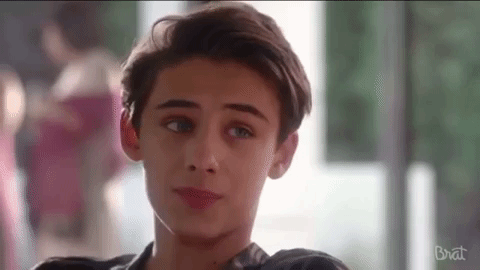
Relationship to them:
Brooke and Harker get along well though they don’t spend that much time just the two of them. They’re both creative and have feelings they’d like to hide from everyone else. Harker's close relationship to Jesper sometimes comes between the two as Brooke feels like Harker would always choose Jesper's side, even when he’s wrong. The two get to spend more time just the two of them during their seventh year when Harker is keeping his distance from Jesper.
Jude Castellan
Faceclaim: Andre Dae Kim

Relationship to them:
Jude is the joker of the group and manages to get Brooke laugh if he wants to. Jude has a tendency to jump into conclusions and not thinking before saying things while Brooke is the opposite. They manage to get into a lot of misunderstanding but over all are close. They both have a close relationship with a Kavinsky family member.
Jesper Greenaway @gaygryffindorgal
Faceclaim: Sebastian Croft

Relationship to them:
Jesper and his family are the whole reason why The Five Club gets involved with The Other World. Brooke and Jesper are both interested about the place and finding out more about it. In the friend group they have the most difficult relationship. They have their issues with the Judy situation and also come from very different backgrounds. Their personalities don’t really match either which causes them to often argue and disagree on things.
Other friends: Judy Bones, Olga Kavinsky @gaygryffindorgal
Person character goes to for advice: His grandparents, sometimes Darby but most often no one.
Person character feels responsible for or takes care of: Hale once Hale returns to the normal world from The Dark Realm.
Person character feels shy or awkward around: Judy at times
Person character openly admires: Sasha Kavinsky is his favourite professor while in school and before they become enemies
► Death
*authors note: more info to be added!*
In the end Brooke chooses to be the one to die so Hale can live. He sacrifices himself for the sake of his friends and closing the way to The Other Realm.
#brooke killingbeck#the five club#hp original story#character profile mine#hp oc#my sad wet rat is here#some details might yet change and i do hope i took away all the plaah's i had in this#character video will follow
10 notes
·
View notes
Text

B A S I C S
Name: Osiric Rivers (Kagon-Malqir, honorary Bayaqud)
Nicknames: Ossy, bumblebee, little bee
Age: 9 (and a half!!!!!!!!!! Very important >:3) as of Dawntrail
Nameday: 19th Sun of the 1st umbral moon
Race: Viera + Miqo'te mixed!
Gender: genderfluid (he/him mostly)
Orientation: Ace
Profession: professonal baby brother!
P H Y S I C A L A S P E C T S
Hair: long and white and curly, very messy! Jai often has to brush out brambles when he's been outside playing
Eyes: one eye is pinkish-red, the other aqua blue
Skin: pale skin with white splotches from vitiligo, also white freckles
Tattoos/scars: light scarring on his wrists (from being grabbed onto in UT), several other minor scars from accidents during play (one on his lip, one on his eyebrow), also has scars from medical procedures, has faint blue facial markings
Other: Os is a tiny and sickly baby! He's often hooked up to IVs for medication or for fluids
F A M I L Y
Parents: Many! Os' birth mom is Julian's (Jai's dad's) sister, N'niki, his dad is Erenville (they shacked up as teenagers for a one off) Os was adopted by Julian and Lhuna, though, and they are Also his parents -- he also considers Khor's parents as his parents
Siblings: Several -- Khor and Jai's babies are all his little siblings, and he has a twin sister, Ophelia (Pheli)
Grandparents: Alaan of the Kagon, (Grandmother) Jhai of the Malqir (Grandfather), N'nyuchi (Grandmother) + Unnamed Nuhn grandfather, also Khor's grandparents
Children: his toys :3
In-laws and Other: n/a
Pets: adores animals -- his family has a ton. Os himself has a little puppy he calls Boof
S K I L L S
Abilities: Os is a little healer -- or learning to be one! He's an empath with a natural affinity for elementals and the fae
Hobbies: botany, drawing, playing, games!
T R A I T S
Most Positive Trait: he's a little sweetheart, with patience and grace especially for young children
Most Negative Trait: far too giving and empathetic
L I K E S
Colors: green! any green
Smells: flowers, the outdoors, baked goods, and sweets, and treats
Textures: soft, fluffy things!
Drinks: milky tea, hot chocolate!
O T H E R D E T A I L S
Smokes: nope
Drinks: allowed a sip or two of kumis!
Drugs: nope
Mount Issuance: has a toy chocobo he pretends to ride around -- also rides around on Jai's back >:3 -- or in Khor's wheelchair
Been Arrested: Not Yet (do not let Jai near anyone trying to)
Tagged by: @starryscale
Tagging: anyone who reads this!
3 notes
·
View notes
Text

BASIC INFORMATION.
full name: warner st. james
age: thirty two
birth date: august 19th
birth place: aurora bay
nationality: american
gender: cis male
pronouns: he / him
orientation: bisexual
neighbourhood: crystal cove condominiums
occupation: video game designer
@aurorabayaesthetic
PHYSICAL APPEARANCE.
face claim: oliver stark
hair colour: light blonde
eye colour: blue
height: 6'2"
weight: 168lbs
build: athletic
scars: n/a
tattoos: an arcanine tattoo on his leg, a pacman tattoo on his arm, family crest above his heart ( he was seventeen and drunk and thought it would impress his mother; spoiler alert: it didn't ) and more!
piercings: none
distinctive feature: birth mark over his left eye
FAMILY.
mother: cassandra st. james
father: matthew st. james
brother: elijah st. james
sister: talon st. james
PERSONALITY TRAITS.
+ observant, creative, empathetic, intuitive, dutiful and affable
- destructive, indulgent, guarded, resentful and short tempered
HISTORY.
being born and raised in aurora bay as a st. james, an affluent family built on generational wealth from the days the little beach town was originally founded, came with high expectations. cassandra st. james was a hard woman to impress and an even harder woman to squeeze an ounce of maternal instinct out of. she had never wanted children, but her husband had worn her down with pretty speeches about legacies and dynasties.
warner st. james was always more comfortable with his face buried into a sketch pad than he was being forced into dinner parties and local community events by his parents, where he would often be found with his aforementioned sketch pad working on his latest character re-design from his favourite video game or comic book.
he wasn't like his brother—charming and able to make people hang on every word he said, nor was he like his sister—as brilliant and clever as she was considered beautiful. warner was leagues behind elijah and talon, struggling with simple reading and writing tasks, which his mother would only berate him for. why can't you be more like your brother, he would have been teaching this class by now and instead you're failing to keep up with even the slowest of dimwits.
each disparaging word was a cruel and devastating blow to his self-esteem and self-worth as it was his pride and yet, warner only found himself seeking his mother's approval even more.
a natural born people pleaser, he only ever wanted cassandra to feel a modicum of pride she felt for her other children for him too, but nothing he seemed to do was good enough for her—he wasn't enough.
it didn't matter how many sports he played, how many assignments he took on for extra credits or how many hours he put in studying only to score a C or D in that subject; it still wasn't enough for his mother.
warner's first act of rebellion came when he was a college freshman, majoring in applied mathematics and engineering with his whole future mapped out for him and he realised, for the first time, that he no longer needed to live under his mother's thumb and he could be whoever he wanted to be.
he switched his major for computer science and video game design, having never given up on his dream to become a video game designer, and landed himself an internship in los angeles with one of the top video game companies once he graduated college.
while living out in los angeles, warner created a twitch account and would often stream himself playing overwatch or fortnite. it was never supposed to become anything, certainly wasn't supposed to amass a large online following who flooded his comment section with love and support. it was started as a hobby, an attempt to earn an extra little income seeing as he wouldn't have his families money as support.
warner spent five years living in los angeles, completing his internship and earning himself a spot with an independent video game company who were slowly building a name for themselves all the while continuing to run his twitch account.
he returned to aurora bay at the age of twenty seven, his job allowing for remote work and making it possible for him to work wherever he wanted without the need of leaving his home. instead of moving back in with his family upon his return, he moved into crystal cove condominiums where he last been living for the last five years
TIDBITS.
once won a cosplay competition at the comic emporium for his geralt of rivera costume
warner has always felt like something was different about him compared to the rest of his family, but he could never quite put his finger on what that difference was until his freshman year of college when he was diagnosed with dyslexia
avid basketball player and lover of most sports... except cross country
rescued a kitten he found on the beach one night who warner is convinced only tolerates him for the sake of a warm bed and a full stomach and chooses violence at any opportunity—aptly named him ares
turned his instagram page private after the leak that exposed his relationship with ziggy
was on his high school and college basket ball team
the definition of a black cat boyfriend
CURRENT CONNECTIONS.
college boyfriend of @atticuscortes whose mother walked in on them making out during his junior year of college
rival twitch streamers who started a secret relationship until their private discord and text messages were exposed online and lead to their break-up with @ziggykyeons
family friend of @noralevin
WANTED CONNECTIONS.
GENERAL
friends from growing up in aurora bay / high school classmates / college classmates / people from his high school and basketball team / friends he made while living in los angeles / friends from twitch / a best friend / ride or dies / gym buddies
ROMANTIC
first loves / unrequited love / will they or won't they / tinder matches / grindr hook ups / one night stands / exes on good terms / gym crush
ANTAGONISTIC
high school rivals / basketball rivals / twitch rivals / exes on bad terms / people that don't fuck with his family / people he has ghosted
2 notes
·
View notes
Text


LEGAL NAME: Cindy Elaine Moon
NICKNAME[S]: Cin, Cin-Cin, Silk, Spider-Man, Analog, Mi Alma, Moon, Moon-Moon
DATE OF BIRTH: May 19th, 1998
SEX: Female
PLACE OF BIRTH: Manhattan, New York
CURRENTLY LIVING: New York, Queens.
SPOKEN LANGUAGES: English, Korean, Spanish (thank you duolingo & photographic memory!)
EDUCATION: Had to dropout of high school to live in a BUNKER for ten years; G.E.D, some college credits from NYU
HAIR COLOR: Black
EYE COLOR: Brown
HEIGHT: 5'6
WEIGHT: (fuck off)
FAMILY INFORMATION
SIBLING[S]: Albert Moon, Jr.
PARENT[S]: Albert Moon, Sr. & Dr. Nari Moon
CHILDREN: Verse dependent.
PET[S]: (sometimes Mallow -- @gwenbiote's cat when I can get away with stealing him)
RELATIONSHIP INFORMATION
SEXUAL ORIENTATION: bisexual
RELATIONSHIP STATUS: thread / verse dependent (weirdly the most stable and adorable is with miguel @halfxspider )
SINCE WHEN: thread / verse dependent
tagged by: @radioactivedadbod
tagging: the two previously tagged (b/c ily'all), @xenjoyedthat, @alchemaxed, @erthlyheavn (for liv!), @redhead-reporter, @spdrwman && anyone else who wants to do this!
10 notes
·
View notes
Note
hi! would you mind explaining a little bit more about sexual inverts? i have been reading maurice and thinking of clive along similar lines, but i think i'm missing some of the context in not understanding 19th to early 20th century's views around sex. i don't really know where to start digging around either ehehehe.
also, if you have time, would you say that while we now think of sexuality and gender as separate, there is still an underlying understanding of sexual desire as comprising the sexes, perhaps in a general context, especially as it relates to heteronormaitivity? thank you~
sorry this took a minute i have gallstones maybe. sexual inversion appeared in medical literature starting in about the 1870s and was popularised more during about the 1920s. the theory was that homosexual desire was the result of normal sexuality located within a person who was constitutionally abnormal, specifically in the manner of mentally having the 'opposite' of their anatomical/genital sex (bisexual desire was thus configured as a kind of intersex/bi-sex position). so, inversion as formulated in this period relied on a notion of a strict human sexual dimorphism, specifically with the two accepted sexes configured as opposite to one another; sexual desire and behaviour were simply part of this configuration of sex. one important thing to note here is that inversion was embraced by some practitioners and homosexuals in an effort to shift away from the idea of homosexuality as a criminal choice and toward homosexuality as an inborn trait (though i would argue that this was not a wholly new idea, as plenty of medical and political discourses viewed criminality itself as an inborn moral defect throughout the 19th century). so, in the invert framework, a gay man had the 'soul' (/mind/desires/&c) of a woman, and vice versa with lesbians being in some sense 'men' internally. homosexual desires were conflated with, and part of a larger narrative of, cross-sex identification and gender nonconformity. crucially, the fact of this desire in itself was already a transgression of assigned sex/gender; thus, in some sense the invert framework really doesn't ontologically allow for, eg, a masc gay man, as the fact of gayness is already and always considered to be a gender deviation.
it's been a really long time since i read 'maurice' and i don't remember thinking of either of them as inverted, but i certainly could have missed that. forster wrote homosexuality as basically inborn and unchosen (hence the failure of maurice's hypnotist, and the quiet tragedy of clive's ending) so there may be some overlap/similarity there.
in the 21st century, gender expression and identity certainly still have a relationship to sexuality and sexual desire; for example, it's fairly common to hear from gay and bi people that even if they do continue to consider themselves cis, they feel some disconnect from their assigned genders in relation to their sexual orientations. the legacy of the invert theory is also part of the puzzle in terms of why transitioning used to be wholly prohibited in the us for trans people who would not be transitioning 'to be heterosexual'. although this is no longer part of the medical guidelines as articulated by wpath &c, there are certainly still plenty of doctors who hold this belief implicitly or explicitly, particularly in their 'evaluations' of trans women (ray blanchard's theory is maybe the most infamous example of this, but is certainly not its only manifestation). i would argue that for the most part, our conception of sex has shifted so much that the invert framework no longer makes sense in most contexts; even strict blanchardians believe on some level that sexuality is something besides a component of sex, and you can tell from how shittily they (and others) actually treat trans lesbians that they in fact do not see them as being equivalent to straight men, but as another category, without access to any of the social benefits men receive (this is a critical aspect of how transmisogyny functions). although sexuality is still part of how people are expected to act out their sexes (bc ofc sex is as socially constructed as gender), you would be hard-pressed to find anyone these days who would defend the argument that the origin of homosexual desire is a constitutional perversion of sex in the way that the invert framework describes. on tumblr at least, there have been some circles of t/erfs and cryptos who tried to 'reclaim' the invert framework but, i would argue, have never really understood what they were actually reclaiming and how it functioned historically, so the appeal was simply to the word "invert" with a peculiarly 21st-century content ascribed to it.
i'll leave some reading recs under a cut; sorry they're almost all british context:
sexual inversion: a critical edition, by havelock ellis and john addington symonds, ed. ivan crozier
'scholars, scientists, and sexual inverts: authority and sexology in nineteenth-century britain' by heike bauer (ch. in: repositioning victorian sciences: shifting centres in nineteenth-century scientific thinking, ed. david clifford)
'historicizing inversion: or, how to make a homosexual', by matt t reed (history of the human sciences, 2001, vol. 14, no. 4, pp. 1–30)
'theorizing female inversion: sexology, discipline, and gender at the fin de siècle', by heike bauer (journal of the history of sexuality, 2009, vol. 18, pp. 84–102)
'the origin of italian sexological studies: female sexual inversion, ca. 1870–1900', by chiara beccalossi (journal of the history of sexuality, 2009, vol. 18, pp. 103–120)
'nineteenth-century british psychiatric writing about homosexuality before havelock ellis: the missing story', by ivan crozier (journal of the history of medicine and allied sciences, 2008, vol. 63, pp. 65–102)
38 notes
·
View notes
Text

“San Francisco – P.M.S.S. Co.’s Wharf- Off for China and Japan” c. 1874. Illustrator unknown (from the collection of the National Parks Gallery).
Ships, Sheds and Wharves: Chinese and the Pacific Mail Steamship Co.
The earliest history of the Chinese in America remains intertwined with the Pacific Mail Steamship Company’s sheds on San Francisco’s wharf and the broader narrative of maritime transportation, immigration, and economic development during the 19th century in California. Founded in 1848 as a response to the California Gold Rush, the Pacific Mail Steamship Company (“PMSSC”) aimed to carry US mail on the Pacific leg of a transcontinental route from the east coast of the US to San Francisco on the west coast via Panama.
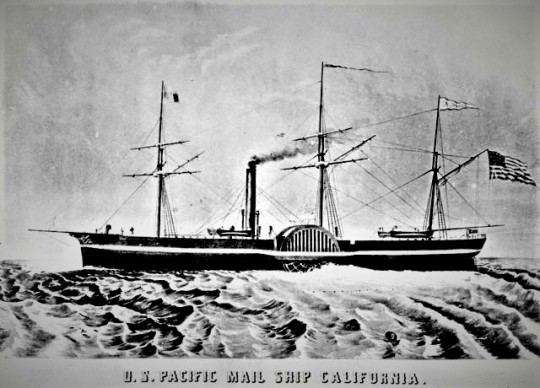
Illustration of the steamship SS California, the first ship of the Pacific Mail Steamship Company. Only a few passengers were on board when the ship left New York on October 6, 1848. By the time the ship reached its stop on the Panama’s Pacific coast, word had spread of the great new find of gold in California. Over 700 people tried to get passage on the ship in that harbor. The Pacific Mail agent managed to cram 365 people aboard the ship before it set sail for California. The ship and passengers reached San Francisco on February 28, 1849, where all but one member of the crew deserted the ship for the goldfields. The ship was lost in a wreck off the Peruvian coast in 1894. (Illustrator unknown, from the collection of the US National Postal Museum)
The discovery of gold in the Sierra Nevada in 1849 produced a massive influx of people to California
from all over the world, including China. According to historian Thomas W. Chinn, “Hong Kong was the general rendezvous for departure to California. The emigrants usually stayed at dormitories provided by the passage brokers or at friends' and relatives' homes until the day of embarkation. The earliest ships between China and California were sailing vessels, some of which were owned by Chinese. . . . However, most of the ships in the early days bringing Chinese immigrants were American or British owned. At the time the shipping of Chinese to California was a very profitable business.”
The voyage in sailing vessels across the Pacific varied from 45 days to more than three months. Chinese passengers typically spent most of the voyage below decks in the overcrowded steerage. Conditions aboard the ships varied with the ship and shipmaster. In March 1852, 450 Chinese arrived in the American ship Robert Browne bound for San Francisco objected to the captain's order to cut off their queues as a hygienic measure. They rebelled, killed the captain and captured the ship. According to Chinn, “health conditions on the bark Libertad were so bad that when she sailed into San Francisco harbor in 1854, one hundred out of her five hundred Chinese passengers and the captain had died during the voyage from Hong Kong.”
In 1866, the Pacific Mail Steamship Company (“PMSSC”) entered the cargo and passenger trade to and from the Orient. As the sole federal contract-carrier for US mail, the PMSSC became a key mover of goods and people and a key player in the growth of San Francisco, California.
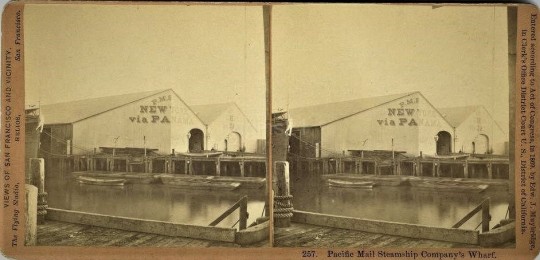
“257. Pacific Mail Steamship Company’s Wharf” c. 1869 -1871. Photo and stereoview by Eadweard J. Muybridge (from a private collection). The Pacific Mail’s wharf at the foot of Brannan Street in San Francisco at the approximate location of its old Pier 36. This was the first waterside view of the city for virtually every Chinese immigrant making landfall in San Francisco.
For the first six decades of the Chinese diaspora to the US, the sheds provided the first experience for every Chinese immigrant on California soil.
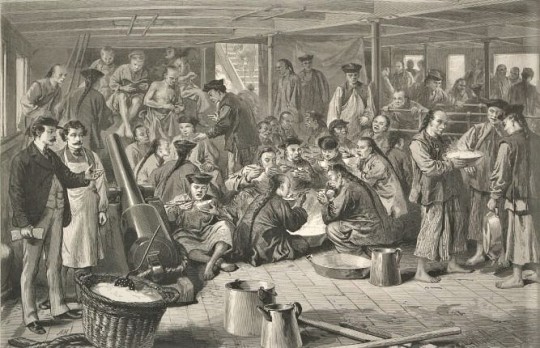
“Chinese Emigration to America,” no date. Illustrator unknown (from the collection of the Bancroft Library). This illustration shows life aboard a Pacific Mail Steamship Co. ship making the passage from China to San Francisco.
Amidst the Gold Rush and burgeoning industries like mining, agriculture, and construction, Chinese immigrants from southern China flocked to California. The PMSSC’s sheds, located along San Francisco’s waterfront, played a crucial role in handling cargo, passengers, and immigrants who arrived via steamships. Serving as pivotal infrastructure, they provided storage space for goods, customs processing areas, and waiting areas for passengers.

Pacific Mail Steamship Co. dock, c. 1864- 1872. Photograph by Carlton Watkins, probably derived from Watkins Mammoth Plate CEW 611. (from a private collection, the Roy D. Graves Pictorial Collection, Bancroft Library; and the San Francisco National Maritime Museum). In this elevated view east from Rincon Hill to the Pacific Mail dock, sidewheel steamer vessels identified by the SF National Maritime Museum as the SS Colorado (built in 1865 and scrapped in 1879), the steamer SS Senator at right (1865-1882), and various sailing ships are seen with Yerba Buena Island in the background. The Oriental Warehouse (built 1867 and still standing at 650 Delancey Street) is at left. The opensfhistory.org site identifies the three-part wooden structure at center as the Occidental Warehouse, used for grain storage, with blacksmith and boiler shops to the left. Ads for C.C. Hastings & Co. Clothing at Lick House can be seen on the fence.
Even as the Gold Rush waned, the PMSSC initiated in 1867 the first regularly scheduled trans-Pacific steamship service, connecting San Francisco with Hong Kong, Yokohama, and later, Shanghai. This route facilitated an influx of Japanese and Chinese immigrants, enriching California’s cultural diversity.
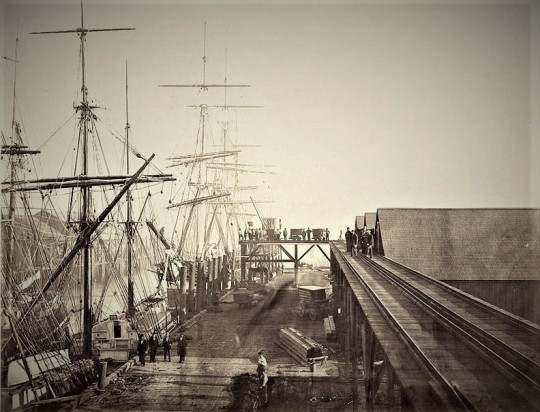
Pacific Mail Steamship Co. docks, c. 1871. Photograph by Carleton Watkins (from a private collection).
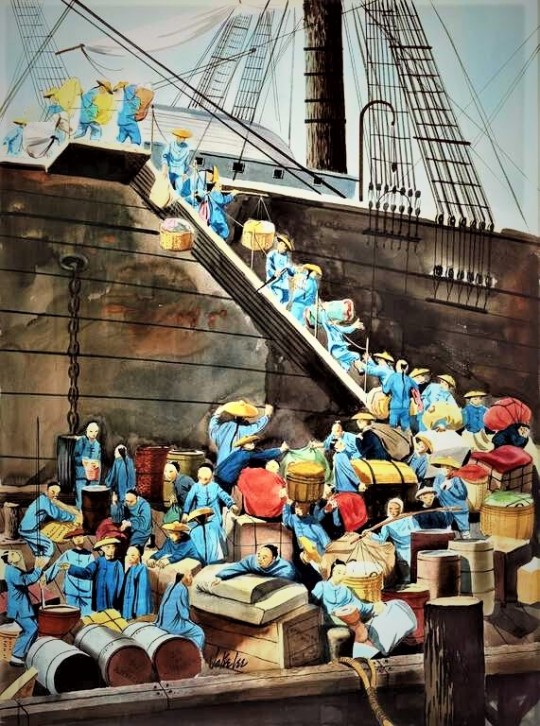
“Disembarking.” Painting by Jake Lee (from the collection of the Chinese Historical Society of America). In this watercolor, one among a suite of paintings commissioned by Johnny Kan for his then-new Kan��s Restaurant on San Francisco’s Grant Avenue in Chinatown, artist Jake Lee depicted a stylized unloading of mostly male passengers at the Pacific Mail Steamship Co. wharf in San Francisco.
When a ship dropped anchor at the dock in San Francisco, the emigrants finally set foot on American soil. A journalist for the Atlantic Monthly in 1869 described the debarkation of 1,272 Chinese as follows:
"… a living stream of the blue coated men of Asia, bearing long bamboo poles across their shoulders, from which depend packages of bedding, marring, clothing, and things of which we know neither the names nor the uses, pours down the plank…. They appear to be of an average age of twenty-five years… and though somewhat less in stature than Caucasians, healthy, active and able bodied to a man. As they come down upon the wharf, they separate into messes or gangs of ten, twenty, or thirty each, being recognized through some to us incomprehensible free-masonry system of signs by the agents of the Six Companies as they come, are assigned places on the long broad shedded wharf [to await inspection by the customs officers]."
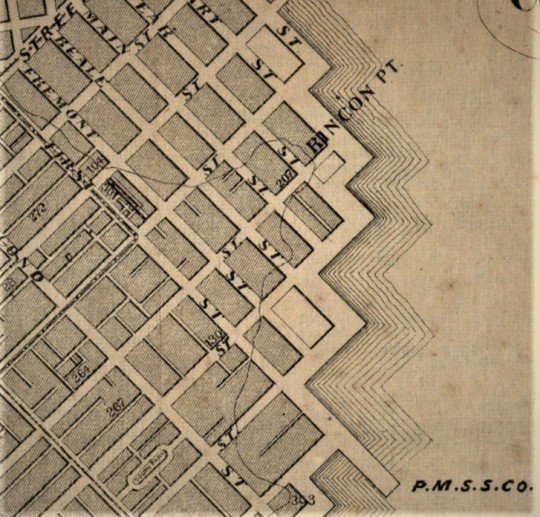
A detail from the "Bancroft's Official Guide Map of San Francisco" of 1873. The lower right corner of the image locates the Pacific Mail Steamship Co. pier at the foot of First Street (at Townsend) running in a southeasterly direction. According to local historian Garold Haynes, "that was before the seawall realignment of the waterfront in the late 1870s."
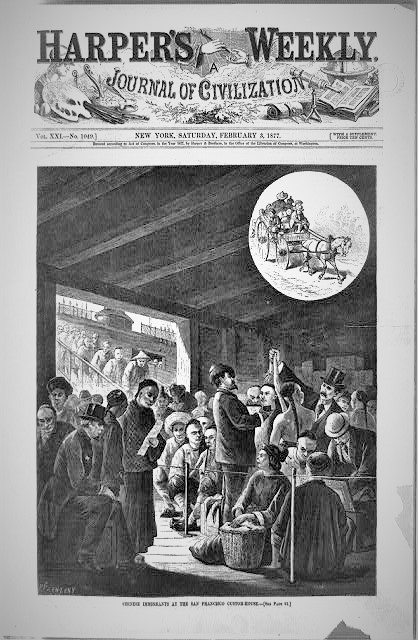
“Chinese Immigrants by The San Francisco Custom House” Harper’s Weekly, February 1877. Illustration by artist Paul Frenzeny (from the collection of the Library of Congress). Chinese immigrants wait for processing in the Pacific Mail Steamship Co.’s sheds while more arrivals from China disembark from the gangway seen in the background.
For many of the immigrants arriving on Pacific Mail steamships, the sheds served as the initial point of contact with the United States. Additionally, the sheds served as immigration processing areas, where Chinese immigrants underwent inspections and screenings. The sheds were a crowded and unsanitary place. Immigrants were often forced to wait for days in the sheds before they could be processed. They were also subjected to medical examinations and interrogations by immigration officials.
As the Atlantic Monthly writer described in 1869 described after each group passed through customs, “. . .They are turned out of the gates and hurried away toward the Chinese quarters of the city hv the agents of the Six Companies. Some go in wagons, more on foot, and the streets leading up that way arc lined with them, running in 'Indian file' and carrying their luggage suspended from the ends of the bamboo poles slung across their shoulders . . .”

In a political cartoon (c. 1888, based on the reference to the Republican Party presidential ticket of 1888 in the upper left corner of the image), Chinese immigrants stream off ships onto the wharves of the Pacific Mail Steamship Co. and the Canadian Pacific Steamship Co. and directly into the factories of San Francisco Chinatown and beyond. Illustrator unknown (from the collection of the Bancroft Library).

"New Arrivals." Date, location, and photographer unknown. The wagon on which the Chinese are riding, presumably having come directly from the Pacific Mail Steamship Co. wharf to San Francisco Chinatown, appears very similar to the 1877 configuration seen in the upper right corner of the preceding Harper's Weekly illustration.
The surge in Chinese immigration led to anti-Chinese sentiments, as reported in the illustrated magazines of the era. The arrival was often violent, as hoodlum elements would sometimes throw stones, potatoes and mud at the new immigrants. After the arrival in Chinatown, the newcomers were temporarily billeted in the dormitories of the Chinese district associations (citing Rev. Augustus W. Loomis, “The Chinese Six Companies,” Overland Monthly, os. v. 1 (1868), pp. 111-117).

“Hoodlums” Pelting Chinese Emigrants On Their Arrival At San Francisco” c. 1870s. Illustrator unknown (from a private collection). A rough sketch of the Pacific Mail Steamship Co. sheds appears in the background.
In San Francisco, local efforts to stop Chinese immigrants moved beyond the sheds and onto the arriving ships, which often became the focal points for Chinese litigants in the local and federal courts.
For example, in August of 1874, the Pacific Mail Steamship Company’s vessel Japan arrived in San Francisco carrying around 90 Chinese women. The Commissioner of Immigration boarded the ship and conducted interviews with about 50 to 60 of these women. From his inquiries, he concluded that 22 of them had been brought to San Francisco for “immoral purposes,” as reported by the Daily Alta California on August 6, 1874. When the Pacific Mail Steamship Company refused to provide the necessary bonds, the Commissioner instructed the ship’s master to keep the 22 women on board.
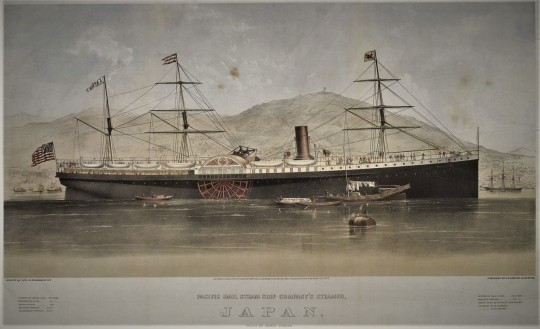
Pacific Mail Steam Ship Company’s Steamer, Japan, c. 1868. Print created by Endicott & Co. (New York, N.Y.), Menger, L. R., publisher (from the collection of The Huntington Library). Junks in the foreground, and, to the left in the background, Hong Kong’s Victoria Peak with semaphore at top appears in the background, center right. The SS Japan is flying the American flag from its stern, a Pacific Mail house-flag from the middle mast, and a pennant with the vessel’s name from the aft mast. A flag flying from the first mast appears to be a red dragon on a yellow field. Print includes vessel statistics and the name of the builder, Henry Steers.
Promptly, attorneys representing the detained women sought legal recourse by requesting a writ of habeas corpus from the state District Court in San Francisco. For two days, legal representatives from various parties engaged in debates over whether the Commissioner’s authority under the law was valid and whether the so-called “Chinese maidens” were indeed involved in prostitution. Reverend Mr. Gibson, who claimed expertise in this area, confidently asserted that Chinese prostitutes could be easily identified by their attire and behavior, likening the distinction to that between courtesans and respectable women in the city. He concluded that only half of the women were destined for prostitution. Ultimately, the District Court ruled that all the women should remain detained and ordered them to stay on the ship.
Shortly before the ship Japan was set to depart, the County Sheriff boarded and brought the 22 women ashore based on a writ of habeas corpus issued by the California Supreme Court. Two weeks later, Justice McKinstry, in a brief opinion on behalf of the court in Ex Parte Ah Fook, 49 Cal 402 (1874), affirmed the lower court’s decision, validating the Commissioner’s authority as a legitimate exercise of the state’s police power.

“258. Steamship Japan in California Dry Dock, Hunter’s Point, San Francisco”c. 1869. A side view of the steamship Japan of the Pacific Mail Steamship Company at the dry dock at Hunters Point. Photograph by Thomas Houseworth (from the Marilyn Blaisdell Collection). The ship would become the setting for a controversial habeas corpus case involving the entry of 22 Chinese women over the objections of state authorities in the case of Ex Parte Ah Fook, 49 Cal 402 (1874).
A third writ of habeas corpus presented the matter to the United States Circuit Court, presided over by Justice Stephen J. Field and Judge Ogden Hoffman. During the oral arguments, Justice Field made it clear that he wouldn’t dismiss constitutional arguments as easily as the state Supreme Court had, emphasizing the principle of equal treatment for citizens and non-citizens.

The Pacific Mail Steamship Co. derrick and coal yard in San Francisco, c. 1871. Photograph by Carleton Watkins (from the collection of the California Historical Society).
In the ruling, Justice Field discharged the petitioners, stating that California’s statute surpasses a state’s legitimate police power and violates the principle of “the right of self-defense.” He noted that the statute could exclude individuals who posed no immediate threat to the state. Judge Hoffman, in a concurring opinion, went further, suggesting that the states should have no control over immigration due to the exclusive nature of the commerce clause.
Although the Circuit Court decision released the Chinese women, while limiting the state’s power over Chinese entry, the Japan case reinvigorated California’s efforts to deter Chinese immigration. The influx of Chinese immigrants coupled with high unemployment in the late 1870s allowed Dennis Kearney of the Workingmen’s Party to target the Chinese as scapegoats. The “Chinese must go” movement gained traction, with both the Republican and Democratic parties adopting anti-Chinese stances.

The Pacific Mail Steamship Co.’s wharf in San Francisco. Photograph by Carleton Watkins (from the collection of the Fine Arts Museums of San Francisco).
During the San Francisco Riot of 1877, the sandlot mob attacked the wharves of the Pacific Mail Steamship Company, because this shipping line represented the primary mode of transportation for America-bound Chinese immigrants headed to California. Although the steamships were not burned, the wharves were partially wrecked. Rioters also burned the lumber and hay yards adjacent to the Pacific Mail wharves.
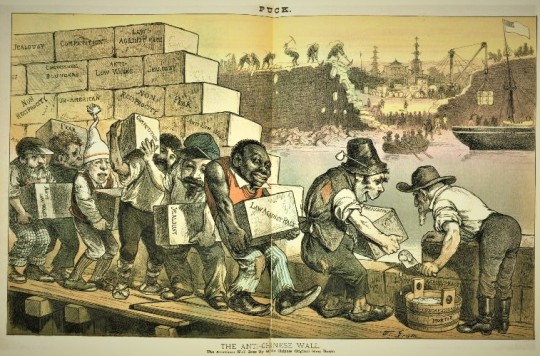
“The Anti-Chinese Wall – The American Wall Goes Up as the Chinese Original Goes Down.” Illustration by Friedrich Graetz in Puck of March 29, 1883 (v. 11, no. 264). The cartoon portrays a multi-ethnic coalition gathered on the wharf to halt Chinese immigration in the aftermath of the passage of the Chinese Exclusion Act in May 1882.
California was able to transfer its racial grievances and resentments to the national stage, culminating in the passage of the Chinese Exclusion Act in 1882. This marked a turning point in the history of Chinese immigration and had profound effects on the Chinese-American community. The Act severely restricted Chinese immigration to the United States.
The use the PMSSC’s sheds posed significant challenges to federal and state attempts to enforce the Exclusion Act (and its punitive extension in the Geary Act of 1892), against all Chinese, regardless of birth or immigration status.
As an article in the San Francisco Call of May 12, 1900, details, the chaotic scene at the Pacific Mall dock where Chinese immigrants disembarked from the ship Coptic was typical for that era. In the Coptic case, federal officials were observed allowing the landing of alleged "coolies" despite the spirit of the exclusion act, causing outrage. The detention shed, initially meant for temporary housing, had become a long-term residence for over 370 Chinese immigrants, generating substantial profit for the PMSSC. The maintenance of this facility posed several concerns, including violations of health regulations and potential disease outbreaks. The Call decried the authorities' negligence in enforcing the law and highlighted the role of a Chinese "ring" in facilitating fraudulent practices and illegal immigration. With multiple ships arriving with more immigrants, the newspaper called for investigation and reform.

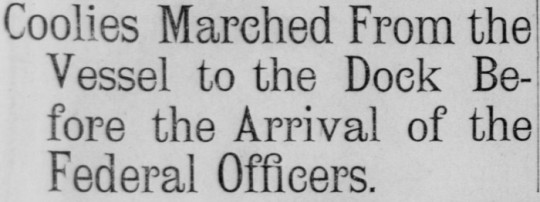


Headlines from the The Call of May 12, 1900, regarding the crowd of detained Chinese immigrants disembarked from the Pacific Mail ships Coptic and America Maru, the lack of security in the Pacific Mail sheds, and alleged immigration fraud.

Illustrations and photographs from the San Francisco Call of May 12, 1900, for its report about the crowd of detained Chinese immigrants disembarked from the Pacific Mail ships Coptic and America Maru, the lack of security in the Pacific Mail sheds, and alleged immigration fraud.
For Chinese and other immigrants and travelers from Asia, the transpacific journey, and even entering San Francisco Bay itself, posed hazards. The dangers were never more evident than in the case of the SS City of Rio de Janeiro. Launched in 1878, this steamship had been an essential component of the Pacific Mail Steamship Company's fleet. Its routes connected pivotal locations such as San Francisco, Honolulu, Yokohama, Japan, and Hong Kong, and the ship had played a role in America's expansion into the Far East and the Pacific in the aftermath of the Civil War and during the Spanish American War.

“A Thousand Boys in Blue S.S. Rio de Janeiro bound for Manila” copyright 1898. Published by M.H. Zahner (from the collection of the Robert Schwemmer Maritime Library). Built by John Roach & Son in 1878 at Chester, Pennsylvania, this vessel had served as a vital link between Asia and San Francisco, regularly transporting passengers and cargo. This stereograph shows its charter by the federal government for use as a military troop transport during the Spanish American War.
On the morning of February 22, 1901, the SS City of Rio de Janeiro commenced its approach to the Golden Gate and the entrance to San Francisco Bay. They had sailed with a crew that was mostly Chinese. History indicates that approximately 201 people were aboard the Rio de Janeiro, as follows: Cabin passengers 29; second cabin, 7; steerage (Chinese and Japanese), 68; white officers, 30; Chinese crewmen, 77. Of the Chinese crewmen, only two spoke English and Chinese. During the long voyage, the ship’s officer gave orders by using signs and signals. The ship’s equipment and lifeboat launching apparatus appeared to be in good working order and were capable of being lowered in less than five minutes.
Near the location of the future location of the Golden Gate Bridge, tragedy struck as the SS City of Rio de Janeiro. In the dense morning fog that obscured the surroundings, the ship collided with jagged rocks on the southern side of the strait, near Fort Point. The vessel’s non-watertight bulkheads led to rapid and unstoppable flooding. In a mere ten minutes, the SS City of Rio de Janeiro succumbed to the relentless forces of the sea.
The majority of the passengers, many of whom were Chinese and Japanese emigrants in steerage, were caught unaware in their cabins as the ship sank. The toll was staggering, with 128 lives lost out of the 210 souls on board. Of the 98 Asians reportedly on board the ill-fated ship, only 15 passengers were rescued, and 41 Chinese crewmen survived.
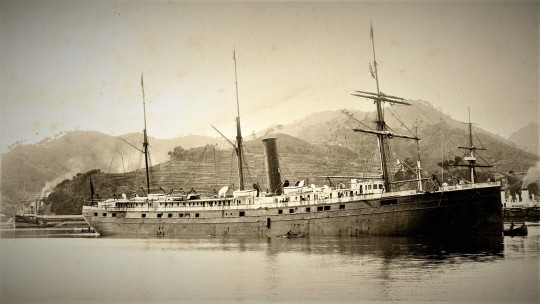
The SS City of Rio de Janeiro in Nagasaki, Japan, c. 1894. Photographer unknown (from the collection of the San Francisco Maritime National Historical Park). The ill-fated ship, which transported passengers and cargo between Asia and San Francisco, sank seven years later after running into rocks near the present site of the Golden Gate Bridge. The never-salvaged shipwreck rests 287 feet underwater.
The sinking of the SS City of Rio de Janeiro represented the deadliest maritime disaster at the San Francisco Bay's entrance, forever etching its name in the annals of maritime history as the “Titanic of the Golden Gate,” drawing a sad parallel to another infamous shipwreck. Today, the case serves as a reminder of the unpredictable forces of nature and the inherent dangers of maritime travel to which thousands of Chinese immigrants and other Asian travelers subjected themselves to gain a better life in America.
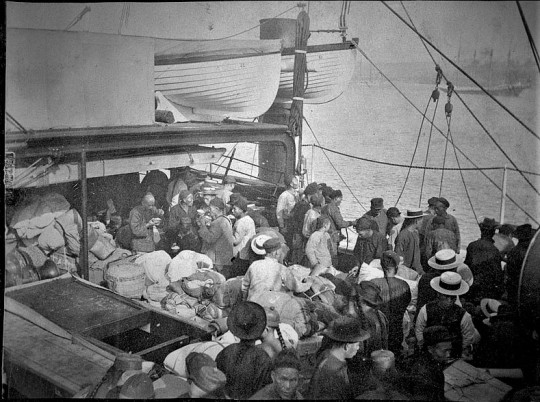
"Chinese Passengers on Deck, 1900–15," enroute to Hawaii. Photographer unknown (from the collection of the Hawaii State Archives). Chinese passengers, some eating from rice bowls, crowd the deck of a steamship. After the Exclusion Acts, the numbers of Chinese voyaging to the US had decreased sharply.
Despite reduced immigration due to the passage of successive exclusion acts in 1882 and 1892, the PMSSC's sheds remained operational, their purpose shifting from off-loading immigrants to facilitating trade and commerce between the east and west coasts of the US.

The Pacific Mail Steamship shed on the San Francisco waterfront at the turn of the century. Photograph attributed to Arnold Genthe. Located at the former pier 36, where Brannan Street runs into the Embarcadero, the immigration station was moved to Angel Island in 1910. Pier 36, the last of the docks at Brannan was torn down in 2012. In just one year, 1852, 25,000 Chinese entered California for the Gold Rush and other opportunities. Chinese America began here.
The convergence of the Central Pacific and Union Pacific railroads in Utah in 1869, had started the process of eroding the Pacific Mail's profitability on the Panama-to-San Francisco route over the ensuing decades, eventually leading to the sale or redirection of many of its ships to other routes.

The Pacific Mail Steamship Co. offices on the southeast corner of Market and First streets in downtown San Francisco, c. 1896. Photographer unknown (from a private collection).
The landscape changed drastically in 1906, when a devastating earthquake and subsequent fire struck San Francisco, including the PMSSC’s wharf facilities. Although destroyed during 1906 disaster, the PMSSC’s sheds were rebuilt shortly thereafter. The sheds continued to be used for detaining and interrogating Chinese immigrants until the opening of immigration station facilities on Angel Island in 1910 for the processing Chinese and other immigrants.
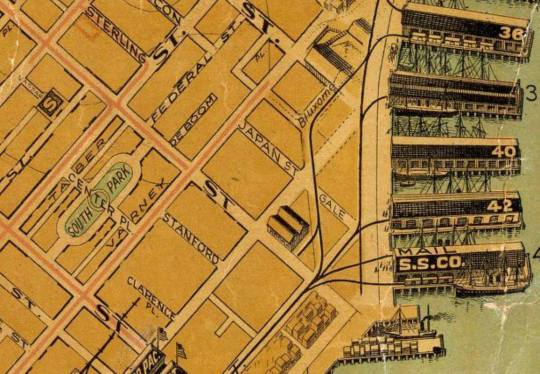
A detail from the August Chevalier Map of 1915. The PMSSC sheds were located on Pier 36 at the intersection of Brannan and First Street.
The legacy of the PMSSC’s sheds, intertwined with their role at the inception of Chinese immigration to California and the US, is deeply rooted in San Francisco's maritime and Chinese American history. Both the company's operations and the experiences of the first wave of the Chinese diaspora arriving on American shores by steamships will remain forever part of the socio-economic dynamics of 19th-century San Francisco and the American West.
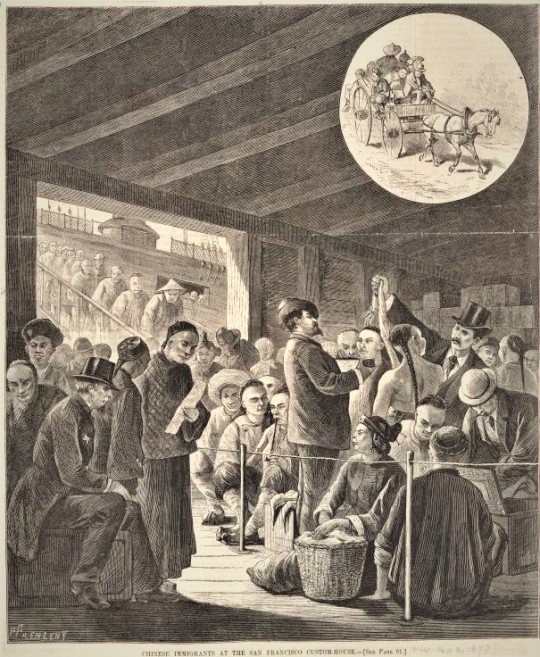
“Chinese Immigrants by the San Francisco Custom House” c. 1877. Detail of the magazine cover illustration by artist Paul Frenzeny for the Harper’s Weekly (from the collection of the New York Public Library.
[updated 2023-10-17]
#Pacific Mail Steamship Co.#Pacific Mail sheds#Chinese immigration detention#Carleton Wtakins#Paul Frenzeny#Harper's Weekly#SS Japan#In re Ah Fook#Stephen Field#Eadweard Muybridge#Pier 36 San Francisco
5 notes
·
View notes
Photo
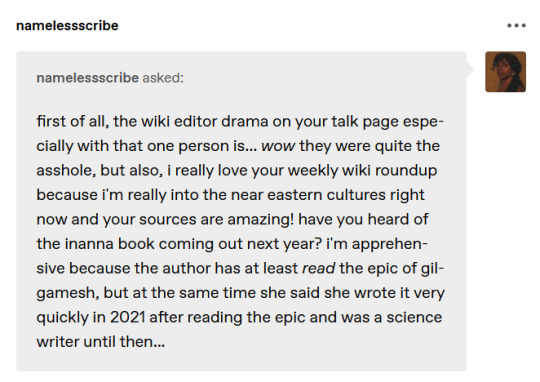
I am not able to respond to this ask normally for some reason hence the screencap.
I have more issue with what they did to literally dozens of articles than about their presence on my talk page, frankly. I still have not managed to track down all, and there are a few cases where I can’t do anything. Whatever, they left for now, and the epicenter of their activity has been locked for the foreseeable future.
I do try to mostly pick sources which can be easily accessed so I'm glad that's working.
As for the book, you mean this one? Truth to be told, the author's declaration troubles me. The Epic of Gilgamesh is possibly one of the worst myths to pick as a starting point for learning about Inanna. It presents a non-standard tradition, with Uruk and Eanna presented as Anu’s rather than hers (something that only holds true for the city in the Seleucid period...), and Paul-Alain Beaulieu went as far as arguing the compilers were biased against her, lol. That alone is a bad omen.
Detailed analysis of what is available atm regarding the book under the cut.
Let’s start with the profile of the author. Nothing too bad or fringe, and I do not think you need to be an Assyriologist or otherwise tied to the history of Iraq and/or Syria to have something worthwhile to say about Mesopotamian mythology, so this alone is hardly a problem.
With that out of the way, time to move on to the article and the fragment of the novel provided there for promotional purposes.
The novel is presented as a "fresh take on the oldest story of all: The Epic of Gilgamesh." Not great - it is not the oldest piece of literature in the world, or even of Mesopotamian literature specifically. In fact, it needed there to be a large corpus and a tradition of intertextuality to even arise. The famous version only goes back to the Kassite period. I do not think any single narrative holds the title of oldest myth, we more or less know what the oldest known piece of literature in Akkadian is (a hymn to Shamash where he hangs out with other judge deities), but good luck guessing which of the Early Dynastic Sumerian literary texts is the oldest.
What's next? "In Athens, they call me Aphrodite now. In Babylon, they call me Ishtar." Not a fan of outright equating Inanna and Aphrodite. Truthfully, there are only two factors that lead to the widespread acceptance of this claim online:
a) classicists are, let’s be honest, one of the types of historians who are just universally treated as better. Only Bible scholars rival them in that regard when it comes to the ancient Near East specifically. From an Assyriological perspective, even today their output about Inanna is, essentially, trash. Hyperdiffusionism and orientalism, long debunked myths, and so on. I saw an example on twitter just the other day. If Assyriologists wanted to match this quality they’d need to treat Apollo, Helios and Sol Invictus as interchangeable and base their perception of him on Madeline Miller’s Circe.
b) goddesses are treated as interchangeable so Ugaritic Ashtart maybe being present on Bronze Age Cyprus and MAYBE influencing the local goddess is basically the same as her being Aphrodite and everyone knows Ashtart is BASICALLY Inanna.
Personally I am very skeptical about such claims of direct descent also because ancient Greek authors just consistently show a completely baffling lack of knowledge about Mesopotamian deities, in contrast with their relative familiarity with Egyptian or Phrygian ones. Meanwhile, cultures which undeniably were influenced by Mesopotamia, like Hurrians, do generally show a solid understanding of the basics.
Cyprus does show pretty clear merging of a “Levantine” tradition with a local one, but that’s… not really Mesopotamian, and does not really prove much beyond “Cypriots and first the inhabitants of Ugarit and later Phoenicians were in contact.” In particular, making vague claims about Aphrodite based on that is just faulty scholarship. Part of me thinks it’s also an echo of 19th century need to prove gods which did not fit the sensibilities of the era were not truly Greek.
Singling out Babylon as a city associated with Ishtar is INCREDIBLY weird too. Why not Akkad? Why not Kish? Why not Mari? There was a distinct “Ishtar of Babylon” especially in the first millennium BCE but she is ultimately of limited importance and, following the modern consensus, was poorly received in Uruk. Does the author think Akkadian was only spoken in Babylon? Is she aware the names were used interchangeably in Uruk itself? Does she even know which cities which deity was worshiped in?
The use of the term Anunnaki non stop is another weird point. Anunna, with later variants Annunaki (ki = "of earth") and Anunna-anna (anna = "of heaven") is, simply put, just a fancy term for a group of deities. “A murder of crows” for deities, if you will. I would go as far as arguing that in many cases there is 0 reason to even leave it untranslated, much like how DIĜIR.MEŠ or other ordinary plurals. It only acquired a specific meaning as a logogram in Hurrian context, where it referred to Enna Turenna, ancestors of other gods, and in first millennium BCE text, where it refers to underworld deities (note that this does not apply to ex. Inanna’s Descent, where Anunna appear in an underworld context but according to Dina Katz are just major gods). That the gods are warring with each other, when coupled with this term, is suspicious too, but more on that in a sec. For now, suffice to say I suspect this is, in fact, not a reference to the "theomachy" seals or anything like that.
The description of Inanna's marriage - one would presume to Dumuzi - is weird. "Forced into a marriage to negotiate a peace"? Political marriage? With Dumuzi? The guy whose mother barely exists outside of texts about him? The guy consistently portrayed as a b list god, who was never a major deity, and whose cult center was a satellite of Uruk of limited importance? Also, is this some sort of deconstruction? Inanna appears in romantic and erotic poetry, that's hardly a topic relevant to political marriage. There are tons of cases which would work for a political marriage story, like deities whose cults were transplanted to new places because of the destruction of their original cult centers who promptly acquired new spouses. the love poetry romantic relationship thing is really hard to miss. Look how many of the Inanna-Dumuzi poems are on ETCSL. And that's not even all there is!
A huge red flag is the focus on gods having children with humans. Demigods are EXCEEDINGLY rare in Mesopotamian mythology. Hell, even fully divine children born out of wedlock seem pretty rare. Gilgamesh is, simply put, a rather unique entity. Sex is pretty common in Mesopotamian literature, but it typically occurs between deities, most commonly between couples.
There is only one type of source I am aware of keen on this sort of speculation - the writings of Zecharia Sitchin, one of the “fathers” of modern ancient aliens, and all around scummy fraud. A good summary of Sitchin’s absolutely deranged views, as well as a thorough debunking based on opinions of exports in every field he invaded has been compiled by Jason Colavito, see here for an online edition. One of the main topics of his nonsensical work is the firm belief in a "war" between Enki and Enlil, which is why I earlier said the mention of war between deities makes me suspicious.
Sitchin pased away a few years ago after like fort years of "research." Sadly, his ideas keep being repeated by the tv show Ancient Aliens (over and over and over again), as well as in similar “literature” - examples are too plentiful to link all, so I’ll limit myself to some funny examples from Colavito s blog like this and this (feat. new age relationship therapists who believe polyamory is the key to defeating the Anunnaki).
Sadly, these “theories” pop up in less expected places too. Their fans include musicians such as Nik Turner (to all of my followers also interested in Mesoamerica, this one’s four you, it’s a crossover episode) and Matt Pike, and various other celebrities around the world, as seen for example here (double feature with “if there are still monkeys, how is evolution real?”). Sitchin is also referenced in one of the leaked emails from a certain famous 2016 case (doesn’t seem the sender was anyone important, tbf). Most bafflingly, in 2016 his claims were presented as truth in a speech given by Kadhim Finjan al Hammami, the Iraqi minster of transportation, which was poorly received domestically for obvious reasons (this is presently the best referenced part of his English wikipedia article; no clue what the Arabic version is like).
I am not aware of anyone credible spelling the name as NinshubAr rather than NinshubUr. A quick search reveals mostly shoddy self-help books, “goddess movement” literature (or, as I like to call it, esoteric terfism) and the like. Meanwhile, every credible source under the sun, and even books I normally dislike, stick to correct Ninshubur (or variant transcriptions thereof with dashes, diacritics etc).
I am also not aware of any source presenting Ninshubur as a warrior deity. Well, source other than Louise Pryke’s Ishtar, a book which dedicated more space to Joss Whedon than to Nanaya. After all, being worshiped alongside Inanna for some 2000 years is nowhere near as important as being a sex pest who wrote some episodes of a shoddy tv show which is like Inanna because...? I no longer remember the logic. It was insane.
If anything, an argument can be made that Ninshubur is the opposite of a warrior deity. Her primary role was to mediate and “soothe hearts” (see here and here) and that's explicitly why she was a popular deity. In none of the narrative texts she appears in is her role even remotely belligerent. The closest she comes to that is Inanna and Enki, I suppose, but it’s still hardly a warrior role. While I have my issues with Olga Tokarczuk’s Inanna novel, Anna In w Grobowcach Świata (I don’t think there is an English translation despite the author’s moderate international success), I actually think it got Ninshubur (my bad, “Nina Szubur”) well, which means it’s something doable even if the author is a self professed Jungian and uses dubious sources. Not a hard bar to clear (with all due respect for Tokarczuk)!
The focus on there being only twelve deities plus Inanna is… incredibly weird. Mesopotamian pantheon was huge, with a lot of local variation. God lists typically enumerated hundreds of deities, with An = Anum, the most extensive known text of this sort, having over 2000 entries, though obviously many are epithets and not individual deities. The humongous numbers show up in Enuma Elish too.
When it comes to actual active worship in individual locations: Paul-Alain Beaulieu’s study of the pantheon of Neo-Babylonian Uruk has entries for around 60-70 (give or take a few since regional hypostases are listed separately), I’ve seen a similar figure given for Early Dynastic Lagash. So I think it’s reasonable to assume that this was the norm for a city pantheon. Not all of these will be big shots,naturally, but a pantheon cannot only consist of gods representing the main cities and a couple of natural forces or celestial bodies. Understanding why the mediators, the personified professions, the spouses and children, the foreign imports and the weird leftovers who do not fit any category are there is pretty significant and I’m not a fan of just glossing that over.
Myths actually do reflect that. Even the famous ones! To use just the example of Epic of Gilgamesh: Sumuqan, the one actual “fertility deity” (he was responsible for, quite literally, the multiplication of animals) is namedropped when Enkidu is first introduced; Ennugi, a courtier of Enlil, is mentioned in the flood section of the story (there’s an incantation which credits him with creating grubs, to illustrate what caliber of deity are we dealing with here), as are Adad’s sidekicks Shullat and Hanish (a pair of twins with a penchant for destruction), in the Old Babylonian version Humbaba’s master is Wer, a distinctly “northwestern” weather god, Aya (“dawn”) plays an active role when Ninsun negotiates with her husband Shamash, and obviously Ninsun and Siduri are both deities (contrary to what some online hot takes presume; the need to demythologize mythology is kind of tiresome). There’s even a goddess only attested there, Silili.
Thirteen does not seem to be a number associated with Inanna anywhere. She does have a well attested numerical association, with 15. The numeral 15, if preceded by the dingir sign, the “divine determinative”, could be used as a fancy logogram to represent her name; hemerologies assign the fifteenth day of the month to her. The logic was basically just “30 is the number of her father (because moon god = lunar month), so a half of that makes sense”, though, it had nothing to do with the number of worshiped deities. Have to be honest, I don’t think I’ve seen either 12 or 13 treated as a religiously significant number in any Mesopotamian text, now that I think of it. I guess there are twelve gods in the curse formula of the Code of Hammurabi? For more see here (it’s old and in German though).
Wait, this is just a “well there are twelve olympians and it’s BASICALLY the same” thing, isn’t it? Oh wait, no. How could I forget Sitchin’s obsession with Mesopotamian deities corresponding to “twelve planets,” with Ishtar/Inanna as a "bonus" without a planet (it does not take much familiarity with Mesopotamian mythology to see the problem). It’s likely just ancient aliens again. Troubling!
There isn’t really a single equally well attested grouping in Mesopotamia, while figures such as 7 and 50 might show up as the number of “great gods” (with no list provided), they are uncommon. Add to this major gods could vary between locations - even between the “core” cities (Nanshe in Lagash, Nanaya in Uruk, Zababa in Kish…), let alone “peripheral” ones, where Dagan, Inshushinak or the pair Teshub and Shaushka appear side by side with “truly Mesopotamian” deities. Given that dealing with this reality was a major aspect of Mesopotamian theology, I think a good modern adaptation should at least try to address it in some way. To be fair, the variability is also true for Greece and its neighborhood, take into account how popular Helios was in Rodos or Hecate in Lagina.
As a side note, where is Utu? Was Inanna born without her twin? What the hell. How does this work. Is this setup for Sitchinesque "the sun is Apsu actually"?
Tl;dr ancient aliens/10, sounds awful.
20 notes
·
View notes
Note
wait, do you have advice/resources for beginning to sew clothes? i self drafted a totebag and have made a few small bags, but am hoping to branch out
Make mockups; do lots of test fittings throughout the process; finish your seams; clip your corners and curves; stitch the most visible and trickiest bits by hand, not machine (unless you're good enough with a machine!); learn the main properties of different fabrics; when you really wanna hold your fabric in place nicely, baste rather than pin; adjust the fit via triangles and curves; it's only fabric; it's okay to fuck up; accept that you WILL fuck-up and WILL have to undo and redo things and that that is OKAY.
^ Some things I personally have benefited from and wish I'd learned earlier!
Seriously, though — I should preface by saying that I myself am also a beginner. I follow some really brilliant costumers and cosplayers here on tumblr, and I am nowhere NEAR their level. (And I would welcome any advice/resources more experienced clothes-makers would like to share!) It's only in the last few years that I've gotten more into sewing, starting mainly with alterations of existing clothes and then moving into making things from scratch. I've figured out a lot just via trial and error — as well as by taking existing garments apart and looking at how they're made.
But, honestly, my main resource has been YouTube. There are tons of tutorials on there for specific techniques and garments, of course, and I do watch those. But I've also learned a LOT from the more entertainment-focused sewing content — the ones where the sewist isn't really trying to teach you how to make something, just making something cool and showing how they made it. There's so much knowledge to be gleaned just from watching them work and listening to them talk about why they used a certain stitch, how they resolved a fit issue, etc.
Some favorite creators include:
TheClosetHistorian: Makes stunning vintage and high-end fashion; big proponent of drafting your own patterns, and has tutorials on how to do so as well as on things like darts and seam finishing. Plus I find her voice and aesthetic very soothing.
Bernadette Banner: Focuses on using period-appropriate methods to create her garments (mainly 19th and early 20th c.), which means a lot of hand sewing. I've picked up a lot of hand-sewing tips and tricks from watching her work.
Vincent Briggs: Mainly 18th century garments, with very excellent tutorials on decorative buttons and buttonholes in particular. And how to make an adorable leaf-kerchief!
Morgan Donner: All-around crafter with a particular focus on medieval garments and other aspects of medieval culture. Does lots of non-sewing craft content I enjoy as well.
Rachel Maksy: Less focused on technical sewing skills and more so on costume making and other crafting, but she's very inventive and fun to watch and shows a lot of creative problem solving.
And a few specific tutorials:
Circle skirt drafting by Mariah Pattie
Making a split-side adjustable skirt by Ash L G
Seam finishing by Evelyn Wood
There are honestly too many good channels to list... Sewstine; The Stitchery; Nicole Rudolph; Shannon Makes...... Beyond the sheer entertainment value, what I really love about watching all of these creators is that each of them has their own particular specialties, preferred ways of doing things, etc. Some of them went to fashion school, some are self-taught. Some are very technical and precise, some of them work organically and messily. And I think that just as the measured, detail-oriented approach of someone like Bernadette Banner offers much instruction, so too (in a very different way) does the chaotic approach of someone like Micarah Tewers, who perhaps can make garment construction seem less intimidating by demonstrating that you don't have to precisely follow a step-by-step guide.
Right now, I'm almost done (SO CLOSE TO DONE) making a skirt. It's not a crazy difficult skirt, but it does have pockets, pleats, gathers, a zipper, an attached waistband with elastic, and a plaid pattern to consider the direction and matching of, so it required thought and planning. I had originally been planning to make the whole skirt using a hand-me-down McCalls pattern, but then decided I didn't like the fullness of that skirt, so I took only the pockets from that pattern and drafted the skirt itself using the circle skirt tutorial linked above. I used a quarter-circle with a 175% waist measurement for the front half, which is pleated, and a 150% waist measurement for the back half, which is gathered. I did frequent test fittings and had to take apart and redo a couple things. And whenever I wasn't exactly sure how to do something, I'd just Google it and find lots of help.
Like I said, some of my mutuals on here are far better at this than I am, and I feel a little silly talking about my skirt like it's some grand accomplishment and a little unqualified to offer resources/advice. But I guess I'm hoping that my experience can still be helpful precisely because I am still a beginner and am very much still in the phase of figuring it all out. And my method is basically to take in information and inspiration from a lot of different sources, find the courage to try things out, learn from my mistakes and try try again.
Congrats on your tote bags, anon, and best wishes on your sewing journeys to come!
6 notes
·
View notes